Comic Strips Templates
- May 4, 2023
- Comic , Free Templates , Printable
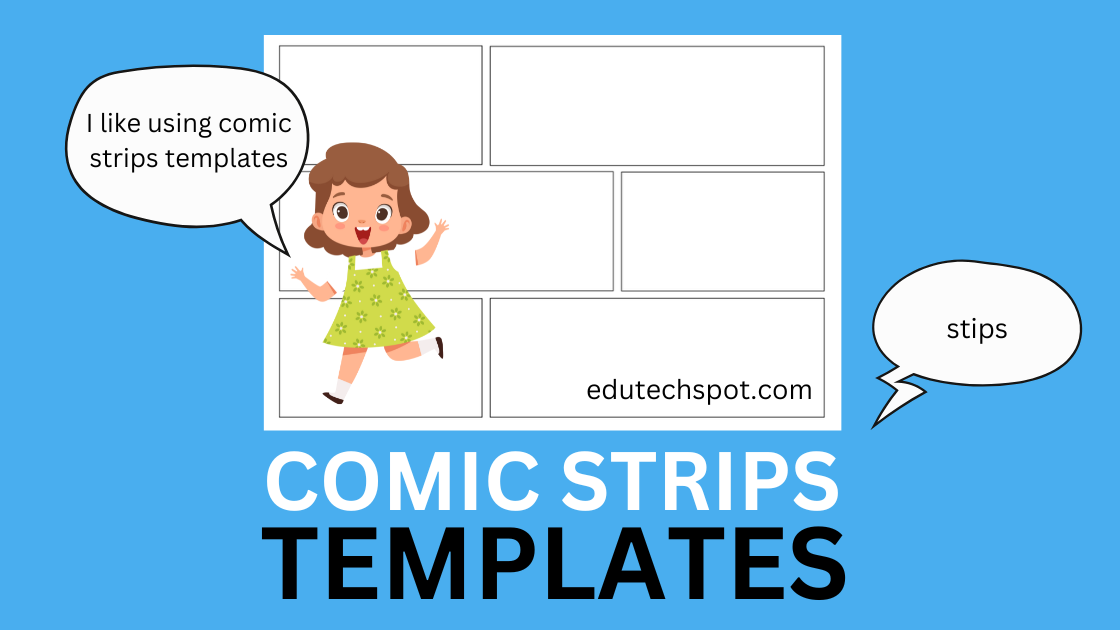
Comic strips templates. Welcome to the world of comic strip creation! Whether you’re an experienced artist or a beginner, the possibilities are endless when it comes to creating your own comics. A good comic strip requires a combination of creativity, storytelling, and attention to detail. But don’t worry, with the right tools and resources, anyone can create a compelling and engaging comic. That’s why I’m here to provide you with some comic strip templates in PDF format that are ready to print and use for educational purposes. These templates will help you get started on your comic-making journey and give you a foundation to build upon. So, let’s get started!
I recommend reading: 21 Free Online Comic Strip Makers | Comic Panels | How to Make a Comic Book on the Computer | Create Digital Art | Free Flash Card Template for Word

Templates for Comic Strips
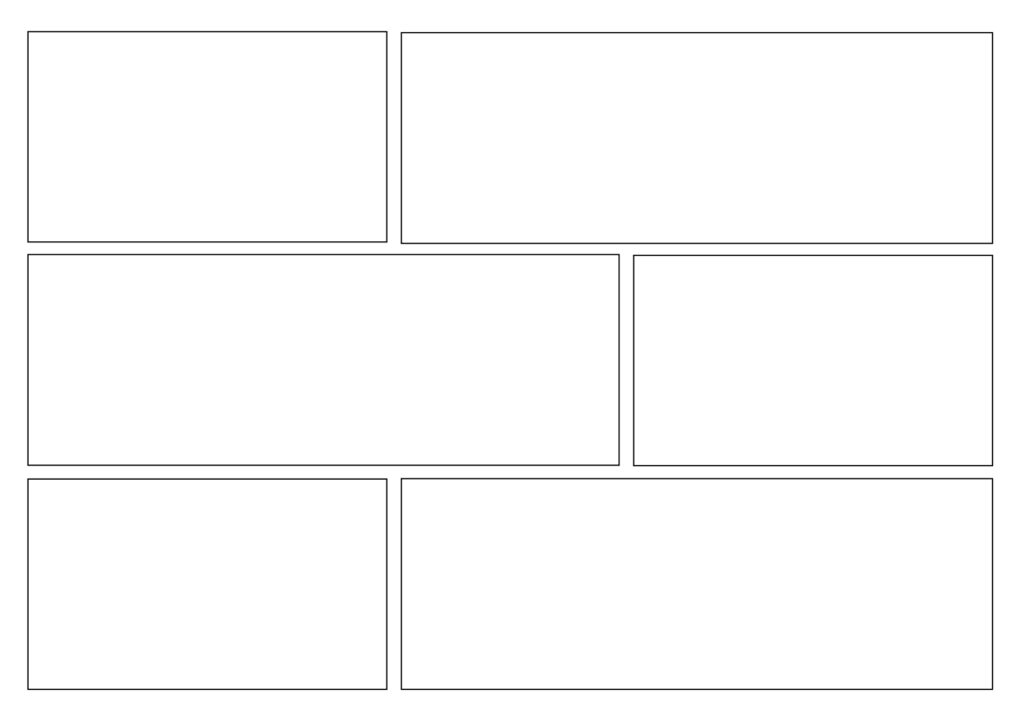
Templates for Comic Strips 1
This panel template contains 6 boxes with alternating size in each row. In general, the layout goes in two columns and three rows. The column width in each row is at alternating size. For example, in the first row, it begins with a column of about 40% width, and the right column that is the second column is at about 60% width. This width composition is then alternated in the following row, that is the second row. The last row goes back to the first composition. This allows students to figure out what kind of event they should input to each column with different width. Sometimes the smaller one can be the focus, and the wider one can be for long view.
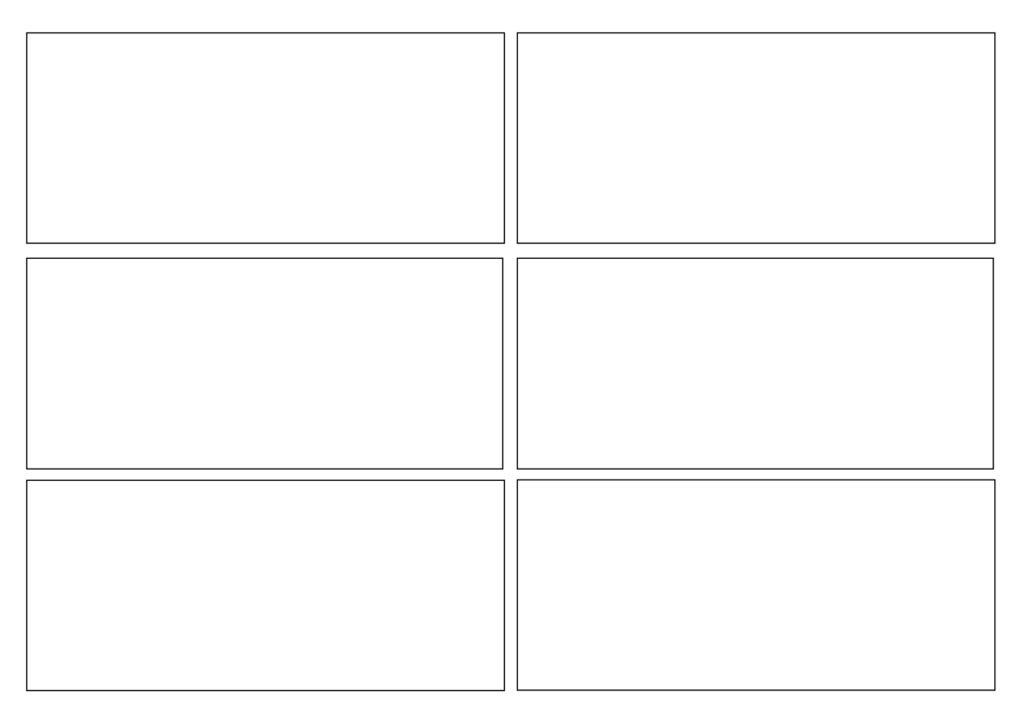
Templates for Comic Strips 2
This second comic strip template panel is arranged in the same width. meanwhile, the composition between the row and column remains the same as the previous one, that is two columns and three rows. The width of each column is the same between the left and the right, that is 50%. I think, this type of comic strip panel is suitable for beginner whose focus is on filling the panel with images and conversation or dialog bulb. The goal is just that the students feel comfortable in participating in the comic making project. As long as the students can put their ideas into the panel, it is considered achieved. Students who are beginner at this process will feel that this task is easy and thus hopefully can motivate them to do the complex ones. Using this similar size panel, they will not find it hard to think about what focus or what specific event should be put in the smaller panel or the bigger panel.
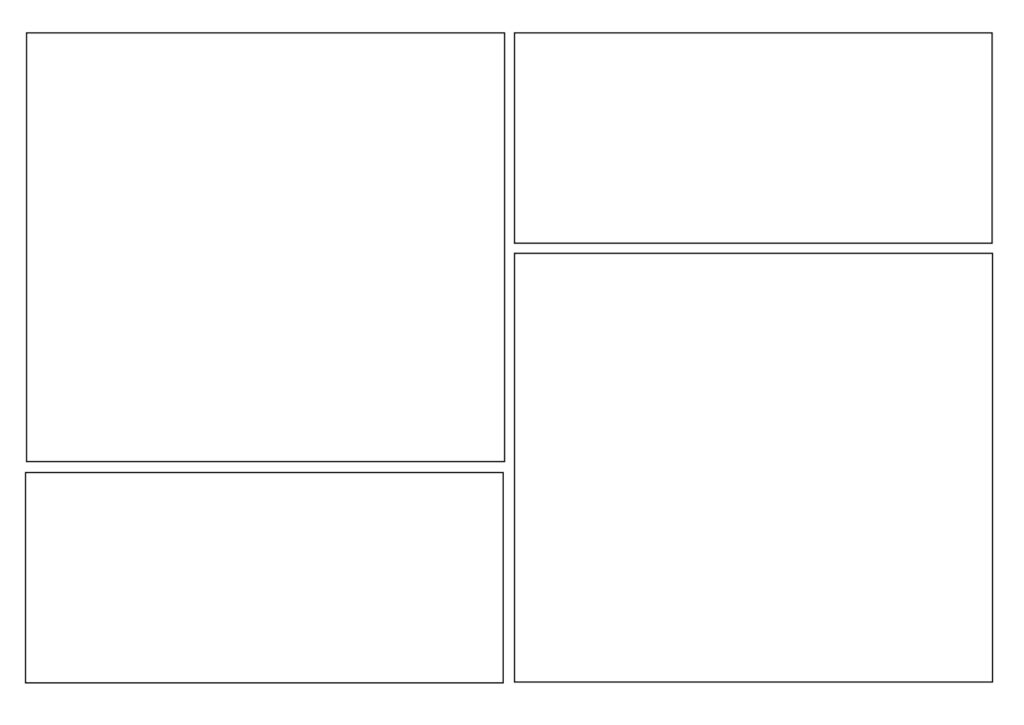
Templates for Comic Strips 3
This comic strip template layout is completely different from the previous ones. This one starts with a bigger size and is in the intersection of the two panels in the right. It feels like a photo collage and is in the masonry style.
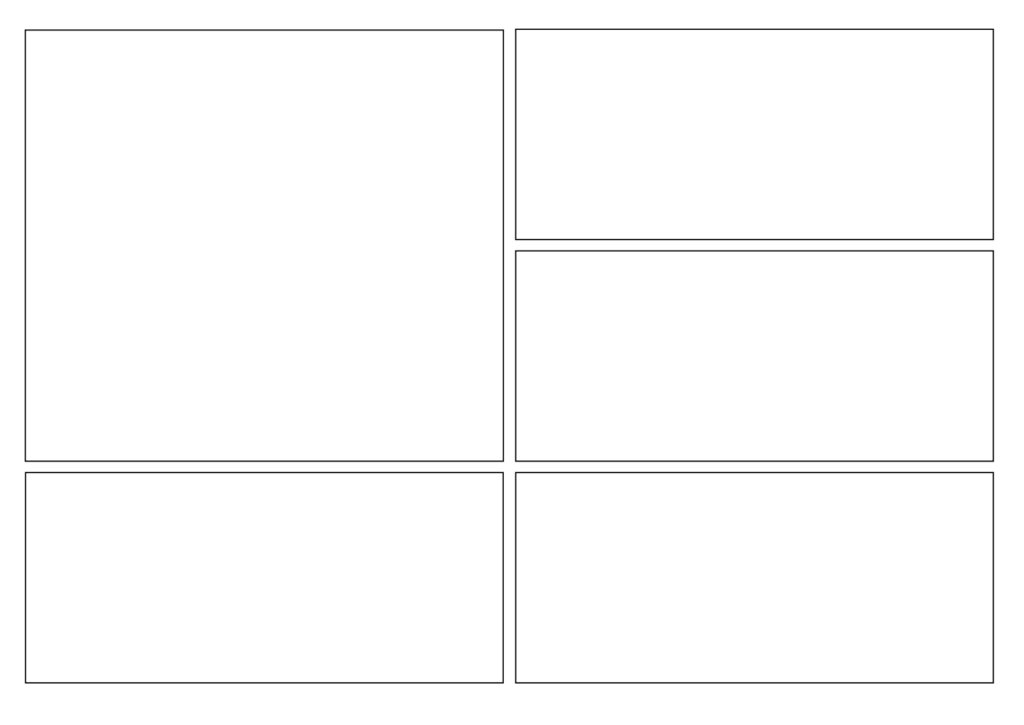
Templates for Comic Strips 4
This layout is also of unique composition. It begins with big square that is inline with two smaller grids at the same size but a half of the bigger one. The bottom part is at the same column with but with smaller height. The opening big square can be used to inform a hook, or an event that is shocking.
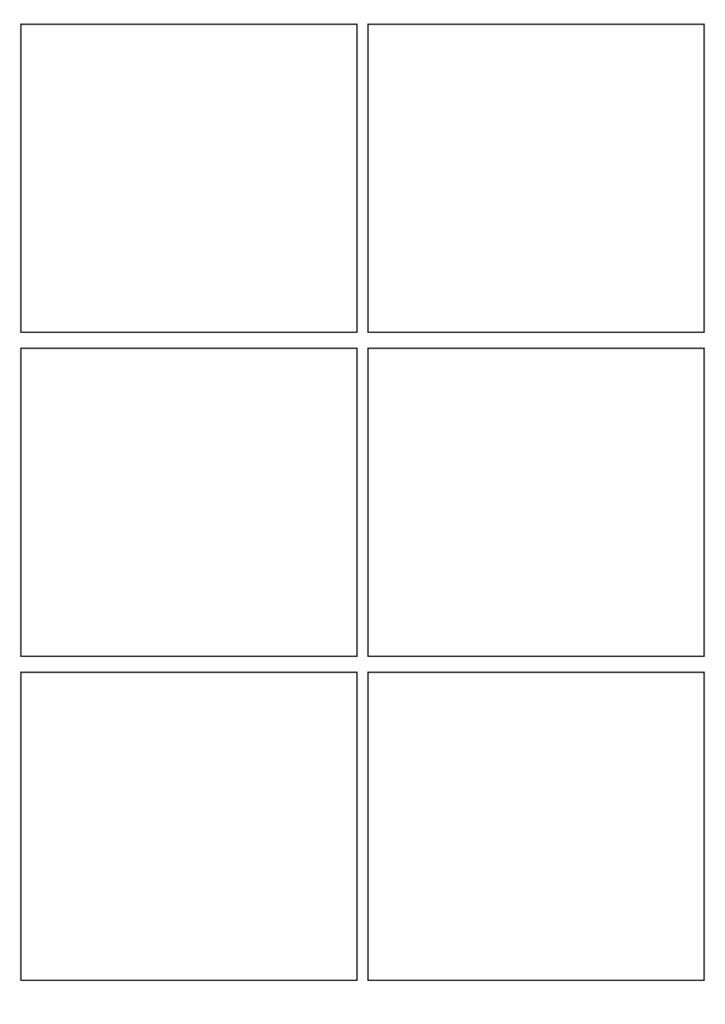
Templates for Comic Strips 5
This layout is similar to item number 2. The boxes are at the same size. There are six boxes in two columns and three rows. They are all in square shapes with the same size. This type of comic strip template is also perfect for beginners who do not have to think about which panel size should be used for which event.
I remember when I was a kid, trying to create my own comic. Initially I was struggling to follow model comic from famous comic books. However, I found it so hard to follow. Some of the panel are overlapped, some others are in triangle, and other unusual forms. Then, I tried to create my own panel, and I came up with panels with the same size. At that time, it gave me ease in drawing as all I have to do is drawing within the panel. I did not need to think hard replicating the professional and advanced unusual shape of comic panel layout.
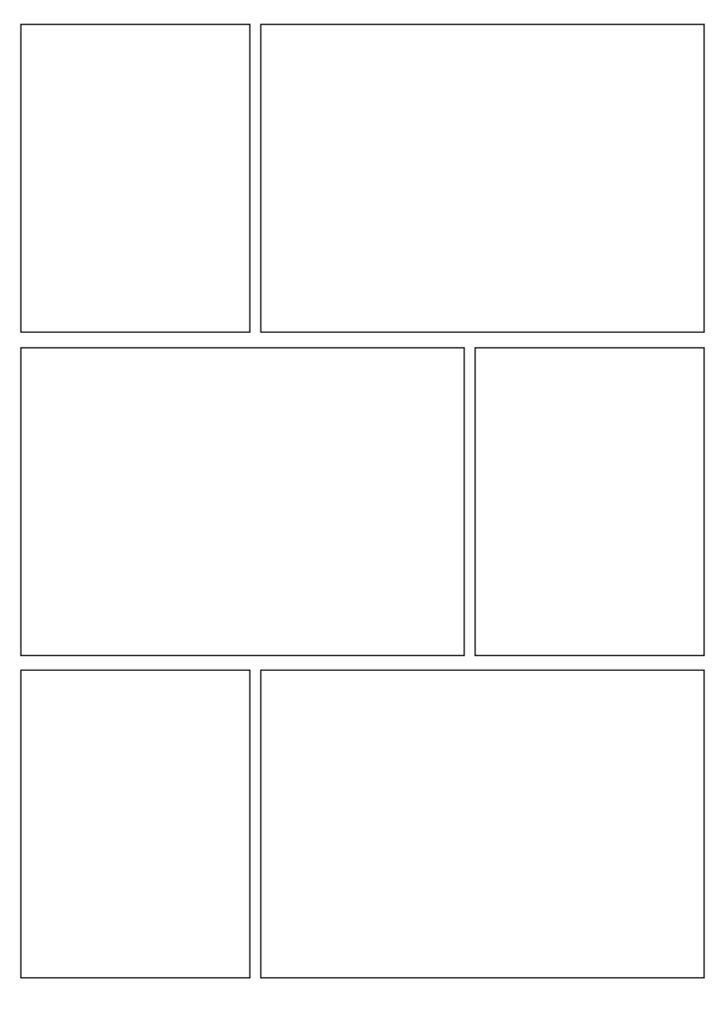
Templates for Comic Strips 6
This one is actually similar to comic strip template number 1, the first in this page. The difference is that it is in portrait while the earlier is in landscape. This is for those who have already practiced drawing comic characters into comic panels for a while. They have already had experience that is enough to go more advanced. This type of panel does require experience because the size of each box is different from one another. One is small and one other is bigger. The student, when using this template, has to adjust specific event that would match the size of the panel. For example, the smaller box can be used to position a man walking, while the right side that is bigger, is to portray when the man is walking, thus require the student to also draw the surrounding.
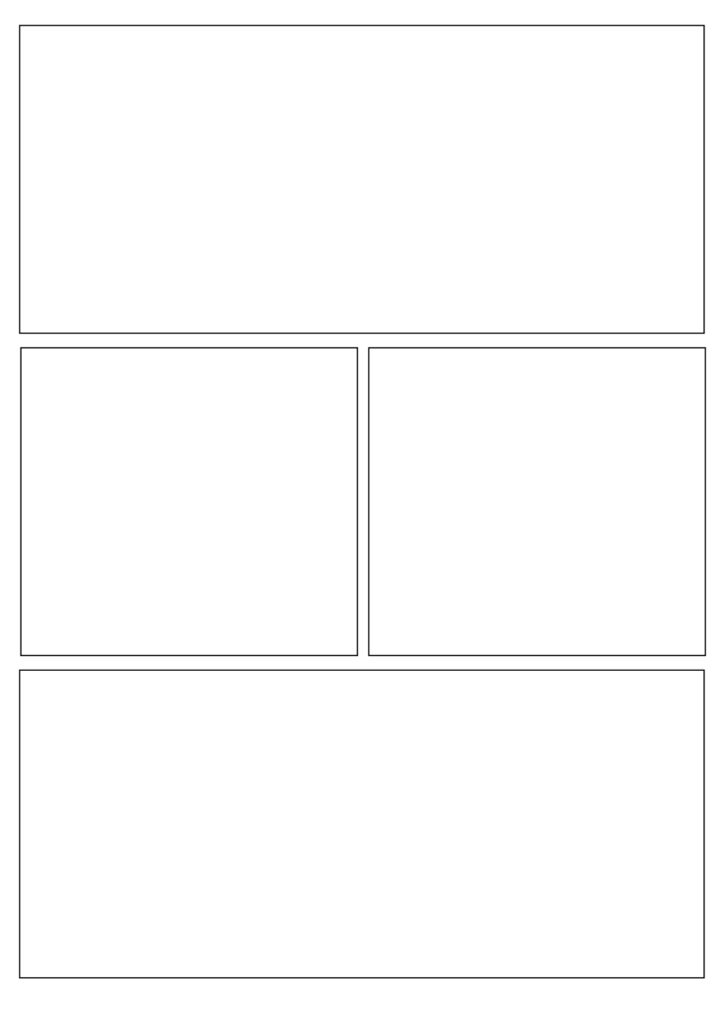
Templates for Comic Strips 7
The comic strip template that features one big panel in the first and third rows, and two equal-sized panels in the second row, is a classic layout that has been used in comics for decades. This type of panel layout is ideal for comics that require a mix of large, dramatic visuals and smaller, more focused scenes.
In the first row, the big panel can be used to showcase a wide-angle shot or a detailed close-up of the scene. This panel is perfect for introducing the setting, characters, or establishing the mood of the story. In the second row, the two equal-sized panels can be used to show two different perspectives of the same scene or to depict a sequence of actions. This layout is particularly effective for showing cause and effect, or for building tension and suspense. In the third row, the big panel can be used to create a sense of closure or to show the aftermath of the events that took place in the previous panels.
To ensure a clear reading order, it is suggested that the speech bubble or dialogue should be positioned close to the characters or objects they are referring to. In the first row, the speech bubble can be placed in the top or bottom corner of the panel, while in the second row, they can be positioned above or below each panel. In the third row, the speech bubble can be placed in the center of the panel or at the bottom, depending on the layout of the image.
This type of comic strip panel layout is suitable for a variety of events, including action scenes, suspenseful moments, and scenes that require a lot of detail. It is particularly effective for comics that want to establish a sense of place or create a cinematic feel. Overall, this classic layout is a great starting point for anyone who wants to create an engaging and visually appealing comic.
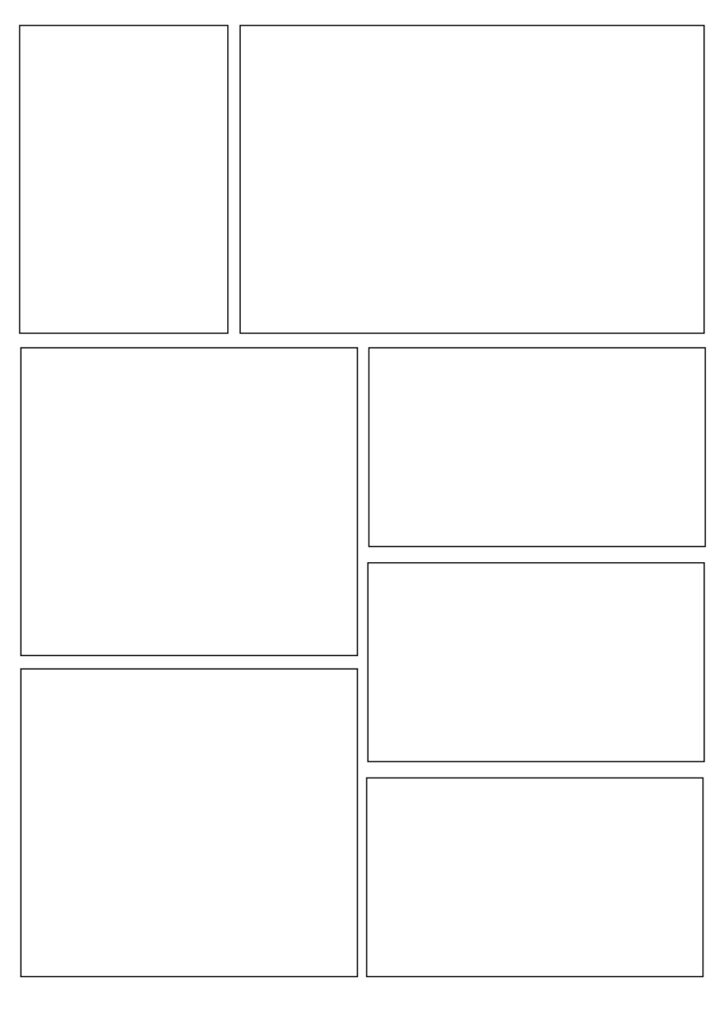
Templates for Comic Strips 8
The comic strip template with a layout featuring two boxes in the first row, a two-column layout in the second row, and a mix of squares and rectangles in each column, is a unique and versatile design that can accommodate a range of storytelling styles.
In the first row, the two boxes can be used to show different perspectives of the same scene or to juxtapose two separate events. The 30% box can be used to show a close-up detail or a smaller moment in the story, while the 70% box can be used to showcase a larger scene or a key event.
In the second row, the two columns provide ample space to create a sequence of actions or to depict multiple characters interacting with each other. The first column can be used to show two big squares, which can be used to depict key moments in the story or to focus on the emotions of the characters. The second column can be used to show three rows of rectangles, which can be used to create a sense of movement or to show a series of related events.
It is advised that speech bubbles or dialogue be positioned close to the characters or things they are referring to in order to guarantee clear communication. In the first row, for example, the speech bubble can be placed above or below each box. The speech bubbles in the second row can be positioned in the middle or near the characters or things they are referring to.
This sort of comic strip panel layout is appropriate for storylines with a lot of information or several plotlines. It’s especially useful in comics if you want to establish a feeling of development or highlight the link between different characters or events.
Comic Strip Template

Comic Strip Template 10 Pages
More collection of comic strip template. There are 10 pages in this archive.
Comic Strip Templates Free
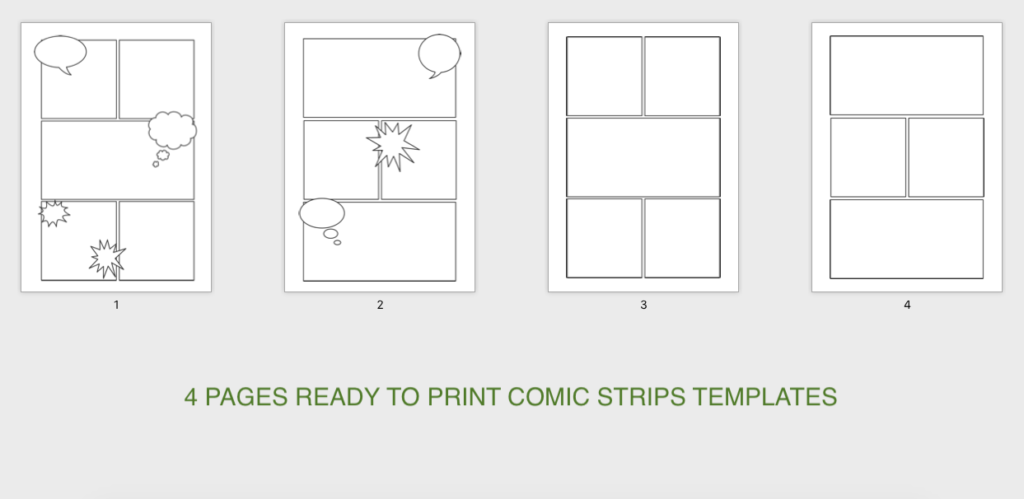
Comic Strip Templates Free 4 Pages
More collection of the templates. there are 4 pages. Two of them are with speech bubbles.
Do you know what comic strip is?
Comic strips are collections of cartoon images contained in a box that can be used to create a story.
The satire style used in newspapers and the heroic storyline used in comic books are just a few examples of the many distinct comic strip styles.
They frequently use boxes to depict new events or actions, which is a popular creative pattern. Cartoon and comic strip characters are almost usually vivid and interesting. The majority of the time, kids speak in what we refer to as “speech bubbles.”
It’s simple to communicate artistic ideas and foster creativity by creating your own comic strip using our templates. They’re a terrific method to provide kids a place to combine their writing and drawing skills.
Why not have your kid or the class try to create their own cartoon strip? It’s a terrific method to encourage creativity and help kids develop their imagination to use a template like the one offered.
My Personal Thoughts
Creating a comic strip can be a fun and engaging way to express your creativity and storytelling skills. Thanks to modern technology, there are now many tools and resources available to help you bring your comic strip ideas to life. One such resource is a comic strip generator, which allows you to quickly and easily create your own comics using pre-designed templates and tools. Whether you’re a seasoned comic creator or just starting out, a comic strip generator can be a valuable tool to have in your arsenal.
When designing a comic strip layout, it’s important to consider the overall structure and flow of the story you’re trying to tell. A well-designed layout can help to guide the reader through the narrative, emphasizing important moments and keeping them engaged from panel to panel. One way to achieve a strong layout is to use printable comic strip templates, which provide a pre-designed framework for your comic and can save you time and effort in the planning process. Blank comic strip panels can also be useful for customizing your layout and making it your own.
A comic strip storyboard is an essential tool for planning and organizing your comic before you begin drawing. This storyboard acts as a visual map of your story, outlining the plot, characters, and overall structure of the comic. Using a comic strip maker or other digital tool can make the storyboard process easier and more efficient. Cartoon panel templates and speech bubble templates can also be useful in creating a cohesive and visually appealing storyboard.
A strong comic strip design is key to making your comic stand out and grab the reader’s attention. Consider the overall aesthetic of your comic, including the style, color scheme, and typography. Using a graphic novel template or comic strip storyboard template can help to establish a consistent design throughout the comic, while comic strip frames and sequential art templates can be used to create dynamic and engaging visuals.
Whether you’re creating a manga-inspired comic or a classic American-style strip, a comic strip drawing template can be a useful starting point for bringing your ideas to life. Printable cartoon panels and comic strip outlines can also be helpful in creating a polished and professional-looking final product. When designing your comic strip pattern, keep in mind the pacing and flow of the story, and use a comic strip storyboard layout to help visualize how the final comic will look and feel. With the right tools and resources, anyone can create a compelling and engaging comic strip.
Important elements of Comic
Comics, also known as graphic narratives, are a form of storytelling that uses sequential art to convey a narrative. The elements of comics can vary depending on the style and format of the comic, but some common elements include:
- Panels: The individual frames or boxes that contain the artwork and text.
- Gutters: The spaces between panels where the reader’s imagination fills in the action that happens between them.
- Speech balloons: The bubbles that contain dialogue spoken by characters.
- Thought balloons: The bubbles that contain a character’s thoughts.
- Sound effects: The onomatopoeic words that represent sounds in the comic, such as “pow,” “bam,” or “zap.”
- Captions: Text boxes that provide additional information, narration, or commentary on the story.
- Characters: The people or creatures that populate the story and interact with each other.
- Setting: The time and place in which the story takes place.
- Plot: The sequence of events that make up the story.
- Themes: The underlying ideas or messages conveyed by the story, which may include social commentary, satire, or personal reflection.
Overall, comics are a highly visual and imaginative medium that combines words and pictures to create a unique form of storytelling.
What is the purpose of this blank comic strip template?
This blank comic strip template is an excellent resource that can be used for a variety of purposes. Comic strip templates are helpful tools that may be utilized while creating comic strips. Comics may be used for a variety of objectives, including amusement and information delivery in an entertaining fashion.
Allow children to create their own comic strips using these templates to encourage student creativity and fine motor skills. They include square spaces for students to draw their own comics, as well as text boxes below each space for students to explain what is going on.
Show them how to insert speech bubbles into each of the boxes in these strips to create an intriguing discussion. Allow them to color their comic strip for added detail. This can help to broaden and enhance advanced vocabulary grammar and story-telling abilities.
How can I put this blank comic strip template to use at home?
For almost a century, children have enjoyed comic strips or cartoon comics. They’re a great method to improve your reading abilities while also enjoying a great narrative with colorful images. They often have a pretty consistent format, with a sequence of images depicting characters and their dialogue in “speech bubbles.”
Some of the most popular and successful movies have been adapted from popular comic strips. Marvel Avengers, Spiderman, Batman, Superman, and the X-Men all began as comic books.
Children will enjoy using this blank comic strip template at home to create their own stories. Why not ask your child to sketch anything related to an event or experience, such as a vacation or a day out?
This is an excellent opportunity for your youngster to communicate their feelings and views regarding their experiences. Suggest that the children keep their comics secure so that they can refer to them later.
Some youngsters may like collecting comics and cartoons, and certain vintage comics are now worth a lot of money, so it may be a fantastic investment!
How to Create Your Own Comic Strip Dialogue
You can use paper, pencils, crayons, and markers, computer word processing programs, or an app.
Allow the person you’re helping to choose the materials they want to use.
Some people like to keep their comic strip dialogues in a notepad or on their smartphone or tablet, so they may refer to them as required and quickly recall essential themes.
With this entertaining comic strip template, you may assist your children say “Happy Father’s Day.” Children will use this project to make their fathers and/or father figures the heroes of their comic books. Inspire imagination in your ELA teaching by using this narrative and sequencing template.
Encourage your students to be as creative as they can, and hang their final comics on the classroom wall. With these printable magazine article templates, you can turn your pupils into junior journalists! Children will compose an article regarding a topic of their choice using our teacher-created sheets.
They can select a real-world theme, such as climate change or activities, or they might write a fictitious narrative. Ideal for K-5 ELA classes. These vivid cut-outs are an excellent way to liven up your classroom.
Students can benefit from
Comic strips are a useful educational tool for students of various grades to utilize in class. They frequently convey messages or offer a quick summary of events or tales. Comics contain all of the tale components – character, place, issue, and solution – in a few frames via a combination of pictures, captions, and dialogue, thus being ideal for use in class while working on these aspects. They are also an excellent approach to encourage reluctant authors to start a tale with the beginning, middle, and conclusion in mind. Utilize these Comic Strip Templates to assist your students create their own comic-style narrative material. The comic might be around them or about any additional characters they create.
What teachers say
Users have left positive comments thanking the provider of free comic strip templates for helping them with various assignments and projects. They express gratitude for the ease of downloading the templates and their usefulness in different scenarios, such as book studies, graphic novel units, and home learning. Some users specifically appreciate the ability to print the templates in larger sizes.
Users seem to be very appreciative of the fact that the comic strip templates are free and readily available, and they mention that they are helpful in facilitating creative expression and learning in the classroom. Some users specifically mention that the templates are useful for students who are reluctant writers or who struggle with traditional writing assignments. Overall, the comments express a sense of gratitude for the resource and highlight the positive impact it has had on the users’ teaching and learning experiences.
The templates are easy to use and provide layout designs that students can use to organize their ideas. users show that the templates are suitable for different grade levels and can be used for various subjects such as literature, history, and computer classes. I recommend using PowerPoint to create the comic strips instead of Word. Some users had issues downloading the templates, but then I suggest using a different browser or making sure pop-ups are not blocked. I allow the templates to be used in virtual classrooms or posted on a private Facebook page for parents. However, they are not for commercial reuse.
Aliv Faizal M
I am a teacher who loves to use technology. I like to design templates in Google Docs, Google Slides, Powerpoint, Word, CorelDraw, etc.
Related Posts

Catchy Preschool Newsletter Examples Ideas

Free Certificate Template – Various Purposes
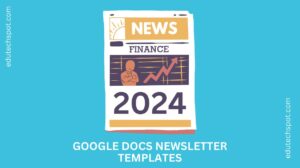
Google Docs Newsletter Templates- FREE [ Best Voted ]

Create 3×5 | 4×6 | 5×8 Index Card Using Template in Google Docs
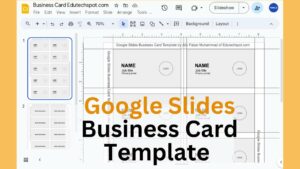
Google Slides Business Card Template Front Back Multiple [FREE]

FREE Agenda Templates for Google Docs Users [Easy Setup]
Leave a reply cancel reply.
The Center for Cartoon Studies
Teaching comics.
This page both archives teaching content from National Association of Comics Art Educators, along with dozens of additional teaching comics resources for all ages developed by The Center for Cartoon Studies community. In recent years the comics medium has flourished, generating much interest from the literary, art, and educational communities. This site will continue to expand with more content as it is developed. Recommended grades, along with Common Core subjects are noted on several resources.
For more information or suggestions, contact [email protected]
Teaching Resources
• Individual Exercises • Complete Lesson Plans • Study Guides and Handouts • Complete Syllabi • Books and Magazines
- Individual Exercises
This section contains a list of short exercises. This material has been contributed by various cartoonists and educators. All items are available in printer-friendly adobe .PDF format.
• The Wrong Planet: Timing, Closure and Editing contributed by Paul Hluchan • Design Vs. Drawing contributed by James Sturm • It’s Easy as Changing the Film contributed by Patrick Welch • Editing contributed by James Sturm • Show Time Passing contributed anonymously • Basic Storytelling… Lights, Camera, Action! contributed by Patrick Welch • Intro to Lettering contributed anonymously • Intro to Inking contributed anonymously • Describing the Complex World contributed by Patrick Welch • Silent Gag Cartoon Exercise contributed anonymously • Poetry and Comics contributed by James Sturm • Comic Strip: Character/Place/Situation contributed anonymously • The Irony of Humor contributed anonymously • Autobiography Do’s and Don’ts contributed anonymously • Think Before You Ink contributed by James Sturm • Scenes as Building Blocks contributed by Tom Hart • 20 Questions for Characters contributed anonymously • Intro to Caricature contributed anonymously • Character Exploration Initial Writing Exercises contributed by Tom Hart • Form and Chaos contributed anonymously • A Definition of Comics contributed by James Sturm • Closure Exercise contributed anonymously [ closure_handout ] • Expressive Lettering and Balloons contributed anonymously [ lettering_template ] • Iconographic Language in Comics contributed anonymously • Cartoon Characters Doodled from Memory contributed by Ivan Brunetti • Practicing Text-Image Relationships contributed by Christian Hill
Back to the top ↑
Complete Lesson Plans
This section contains a list of lesson plans. This material has been contributed by various cartoonists and educators. All items are available in printer-friendly adobe .PDF format. Each lesson plan has, listed after its title, a grade range for which the exercise is most appropriate. Many lesson plans, though, can be modified to suit older or younger classes as needed.
- Little Orphane Annie: Leapin’ Through the Depression contributed by Joanna Boyd Richards [ sample Annie strips .pdf 2.4MB]
- Teaching Literary Devices with Comics contributed by Nancy Frey and Doug Fisher [ sample narrative .pdf 2MB]
- The Serious Business of Graphic Novels contributed by A. David Lewis [ slideshow .ppt 8.5MB]
- Creating and Self-Publishing Your Minicomics contributed by Mac McCool
- Study Guides and Handouts
This section contains study guides which are geared toward English/literature classes as well as a studio environment. Also available here are handouts useful for class discussion. Several of the study guides contain reading questions designed to facilitate the teaching of prominent comics works. All items are available in printer-friendly adobe .PDF format.
Study Guides: • The Complete Peanuts Volume I by Charles M. Schulz contributed by Art Baxter • Buddy in Seattle by Peter Bagge contributed by Ben Towle • Above and Below by James Sturm contributed anonymously • Locas: The Maggie and Hopey Stories by Jaime Hernandez contributed by Art Baxter • Jimbo in Purgatory by Gary Panter contributed by Joel Priddy • You Can’t Get There From Here by Jason contributed by Christian Hill • Flies on the Ceiling by Los Bros Hernandez contributed by Rocco Versaci • My Troubles with Women by Robert Crumb contributed by Rocco Versaci • Ghost World by Dan Clowes contributed by Rocco Versaci • Daddy’s Girl by Debbie Drechsler contributed by Rocco Versaci • Sandman: Fables and Reflections by Neil Gaiman contributed by Rocco Versaci • Palestine by Joe Sacco contributed by Rocco Versaci • Watchmen by Alan Moore and Dave Gibbon contributed by Rocco Versaci • Maus by Art Spiegleman contributed anonymously
Handouts: • The Creation of a Page contributed by Tom Hart • Three-Act Story Structure contributed anonymously • Women in Comics: An Introductory Guide contributed by Trina Robbins • Critique Talking Points contributed anonymously • Usagi Yojimbo: Step by Step contributed by Stan Sakai • Mix and Match Rows: Comics Handouts for Younger Students contributed by Ben Towle • Comics Terminology contributed anonymously • How To Read Nancy contributed by Mark Newgarden and Paul Karasik
- Complete Syllabi
In this section you will find a number of complete course syllabi, most if which are intended for teaching at the undergraduate level. The syllabi are divided into sections for studio classes and non-studio classes and have been contributed by instructors from institutions such as Yale, The Savannah College of Art and Design, The University of Florida, and The Massachusetts Institute of Technology, as well as others.
- Comics As Literature contributed by Rocco Versaci
- Comics and Animation contributed anonymously
- Comics in American Culture contributed by Professor Touponce
- Media in Cultural Context: Comics, Cartoons and Graphic Storytelling contributed anonymously
- Survey of Sequential Art contributed anonymously
- Writing About Comics contributed anonymously
- Writing Scripts for Comics contributed by Mark Kneece
- Introduction to Comics Art: Gateway to Visual Storytelling contributed anonymously
- Reading Comics as Literature contributed by Isaac Cates
- Studies in Literature and Culture: The Graphic Novel contributed anonymously
- Comics Studio Class contributed anonymously
- Explore Chicago: The Art of Chris Ware contributed anonymously
- An Aesthetic History of Comics contributed by Dan Nadel
- History of Comic-Book Art contributed by Andrei Molotiu
- Image, Text, and Story: An Exploration of Graphic Novels contributed by Rachel Williams
- Books and Magazines
The reference material here consists of books and magazines which may be useful to educators teaching classes in comics or cartooning. Most of the items listed are instructional in nature, but a few are critical or analytical texts relating to the cartooing artform; Scott McCloud’s Understanding Comics is probably the most well known of these. Several items listed are currently out of print, but reasonably priced copies can usually be located via bookfinder.com .
The Arbor House Book of Cartooning by Mort Greenberg ISBN 0-87795-399-6 New Yorker cartoonist Greenberg shares his knowledge in this comprehensive volume. There seem to be thousands of these “how-to cartoon” books. This (along with Polly Keener’s book) is one of the better ones.
The Art of Comic Book Inkin g by Gary Martin ASIN: 1569712581 Pretty good introduction to inking tools and concepts. Especially good at identifying methods of implying shade and weight on a human figure. A number of variations on the same pencils by differing comic book inking pros offer a good look at many ways a page can be successfully inked.
The Art of Dramatic Writing by Lajos Egri ISBN: 0-671-21332-6 A seminal 20th century book on playwriting, and the introduction to the “dramatic statement” inherent in any play. The book is very instructive in looking at the elements of your story and examining which are contributing to the greater theme, and which are not. Like David Mamet’s book, it has little room for other opinions of how drama is constructed but certainly presents its own thesis clearly and completely.
Cartooning by Polly Keener ISBN: 0131179128 Although geared towards gag cartooning and comic strips, this book offers a great deal of information from generating ideas to tools and techniques. Covers a lot of the same ground as The Arbor House Book .
Comics and Sequential Art by Will Eisner ISBN: 0961472812 Taken from Amazon.com reader reviews: “Written years before Scott McCloud’s “Understanding Comics,” Will Eisner expounds upon how comics are a visual, reading experience using both words and pictures. He instructs the reader in how words and pictures can be used together to tell a story. The author must lead the reader with visual clues to each sequential image. Mood, emotion, even time can be expressed visually in a comic. Camera angles, panel borders, typefaces, all play a part in the effectiveness of a story.”
Comix 2000 by L’ Association Editors Essential cross section (2000 pages) of silent comics from across the globe. Countless examples of innovative silent storytelling.
The DC Comics Guide to Pencilling Comics by Klaus Janson ISBN: 0-8230-1028-7 Klaus Janson’s book is a distillation of all his techniques and theories. A great book divided into 3 parts: drawing, storytelling and pencilling. Drawing focuses mostly on human anatomy. In Storytelling, he discusses the art of panel juxtaposition, including a nuanced look at juxtaposing unrelated images. He also offers an extensive and detailed look at panel arrangement, including composition both on the page and within the panel. The pencilling section offers a look at Janson’s process on an entire short story, from script to finishes. Overall intelligent, humble, and masterful.
Drawing Comics Lab: 52 Exercises on Characters, Panels, Storytelling, Publishing & Professional Practices (Lab Series) ISBN: 9781592538126 This easy-to-follow book is designed for the beginning or aspiring cartoonist; both children and adults will find the techniques to be engaging and highly accessible.Featured artists include:- James Stu
DRAW! Magazine Quarterly , published by: TwoMorrows Publishing PO Box 2129 Upper Darby, PA 19082 This weighty magazine features numerous useful columns each issue. Past columns have included an extensive look at inking by Klaus Janson, a look at character design by Genndy Tartakovsky (creator of Cartoon Network’s Samauri Jack ), an article on observation and set design by Batman set designer Paul Rivoche, and figure drawing by Brett Blevins.
Graphic Storytelling by Will Eisner ISBN: 0961472820 From the publisher: “A companion to Comics & Sequential Art , this book takes the principles examined in that title and applies them to the process of graphic storytelling. Eisner shows comic artists, filmmakers and graphic designers how to craft stories in a visual medium. They’ll also learn why mastering the basics of storytelling is far more important than the hollow flash and dazzle seen in lesser work. Readers will learn everything from the fine points of graphic storytelling to the big picture of the comics medium, including how to: * Use art that enhances your story, rather than obscuring it * Wield images like narrative tools * Write and illustrate effective dialogue * Develop ideas that can be turned into dynamic stories. These lessons and more are illustrated with storytelling samples from Eisner himself along with other comic book favorites, including Art Spiegelman, Robert Crumb, Milton Caniff and Al Capp. “
The Hero with a Thousand Faces by Joseph Campbell ISBN: 0691017840 Seminal and definitive look at world mythology and the “shared stories” therein. From African mythology, to Norse, to American Indian, the elements of myths are often similar. Campbell outlines these and as such, furthers Jung’s mapping of humanity’s unconscious hopes, desires and fears.
On Directing Film by David Mamet ISBN: 0140127224 There is no better description (told in essay form and also transcribed dialogues with his students) of how to proceed from an idea to a no-nonsense visual, dramatic rendition of that idea. The book is a perfect expression of its goal to outline the thinking steps involved in planning out a scene or series of scenes. For Mamet, all the expression lies in the script and in the SHOT LIST. Even his use of actors (as people who just get up, hit their marks and say their lines and shut up) is extreme. Nonetheless, he is completely self-assured of his points of view, and in learning his method of outlining a scene before beginning the filming or drawing, I can’t imagine a better explanation.
Perspective for Comic Book Artists by David Chelsea ISBN 0-8230-0567-4 Both an introduction and comprehensive course in perspective tailored specifically for Comic Book artists (and told in comics form.) People who don’t know perspective will finally learn what they’ve been doing right. Even those that think they know perspective will probably walk away with their heads spinning and full of new insights. Exhaustive and somewhat confusing if you don’t want to do the math.
Smithsonian Collection of Newspaper Comics by Bill Blackbeard ISBN 0-87474-172-6 Essential introduction to the comic strips of the early 20th century.
Story by Robert McKee ISBN 0-06-039168-5 One of the world’s premiere screenwriting teachers dissects and defines the elements of a story. Sort of the Understanding Comics for screenwriters.
Syllabus by Lynda Barry ISBN 1-77046-161-2 Barry teaches a method of writing that focuses on the relationship between the hand, the brain, and spontaneous images, both written and visual. It has been embraced by people across North America—prison inmates, postal workers, university students, high-school teachers, and hairdressers—for opening pathways to creativity.
Wishes, Lies, and Dreams: Teaching Children to Write Poetry by Kenneth Koch ISBN 0-05-080530-7 A classic in its field, this book is a vivid account of a poet’s experience teaching Manhattan schoolchildren to write verse. The book provides great ideas for creating assignments that excite students and get the creative juices flowing.
The Writer’s Journey: Dramatic Structure for Storytellers by Christopher Volger ISBN: 0941188701 Overview of Joseph Campbell’s “Hero’s Journey” ideas and their use in Hollywood storytelling. Though simplistic, it is surprisingly useful if used correctly, meaning not as formulae, but as dramatic tools. Outlines a series of 12 steps in many stories — exemplified by Wizard of Oz but also evident in Titanic and surprisingly, even Tarantino’s Pulp Fiction. All in all a good job of cracking open the traditional story structure and peeking inside.
Writing Down the Bones by Natalie Goldberg ISBN 0-87773-375-9 Lots of exercises to get writers going. Exercises, like the Kenneth Koch book, can be easily translated for a comic artist.
The Writing Life by Annie Dillard ISBN 0-06-016156-6 A great writer writing about the creative process. Dillard offers bits of technical information but more importantly she lays out a realistic perspective on the trials and challenges of making art and the dedication needed to persevere.
Understanding Comics by Scott McCloud ISBN: 006097625X Comprehensive examination of the mechanics of the art form; from mapping of iconographic imagery to an new nomenclature for transitions between comic panels (and a mapping of those as well.) Great overview and introduction to the intellectual tools involved in creating comics.
Your Career in Comics by Lee Nordling ISBN 0-8362-0748-3 If you want to make it as a comic strip artist, then this is the book for you. Nording looks at cartooning from three perspectives: the cartoonist’s, the newspaper editor’s, and the syndicate editor’s. He interviews dozens of professionals providing both a broad-based view of the art form and the nitty gritty of fashioning a solid comic strip.
- Promoting a Comics Curriculum
One of the primary the goals of NACAE was to assist educational institutions and individual educators interested in establishing a comics art curriculum. The materials below are collected from various sources and outline some of the advantages of implementing sequential art/comics art classes and curricula.
- A Case For Comics contributed by James Sturm
- Seika University’s Department of Comic Art contributed by Matt Thorn
- How Comic Books Can Change the Way Our Students See Literature: One Teacher’s Perspective contributed by Rocco Versaci
- Comics in the Classroom contributed by James Sturm
- Interview with Michael Bitz of The Comic Book Project contributed by Christian Hill
Using These Materials
Q: How am I allowed to use the material on this page?
A: Unless otherwise noted, materials on this page are free to use, reproduce, and distribute as long as they are being used for non-commercial educational purposes. Please follow these guidelines when using these materials:
- You may not use any materials contained on this site for commercial purposes
- You must attribute the work as described below
- If you alter, transform, or build upon this work, you may distribute the resulting work only under a license identical to this one.
- To properly attribute content copied, distributed or displayed from this site, include the following information: Copyright © [name of originating author] via NACAE
Connect with Us
Mfa and certificate program, make a gift to ccs, online and in-person workshops, join ccs enews, cartoon club, the schulz library, free one-week cartooning workout, a free one-week cartooning workout.
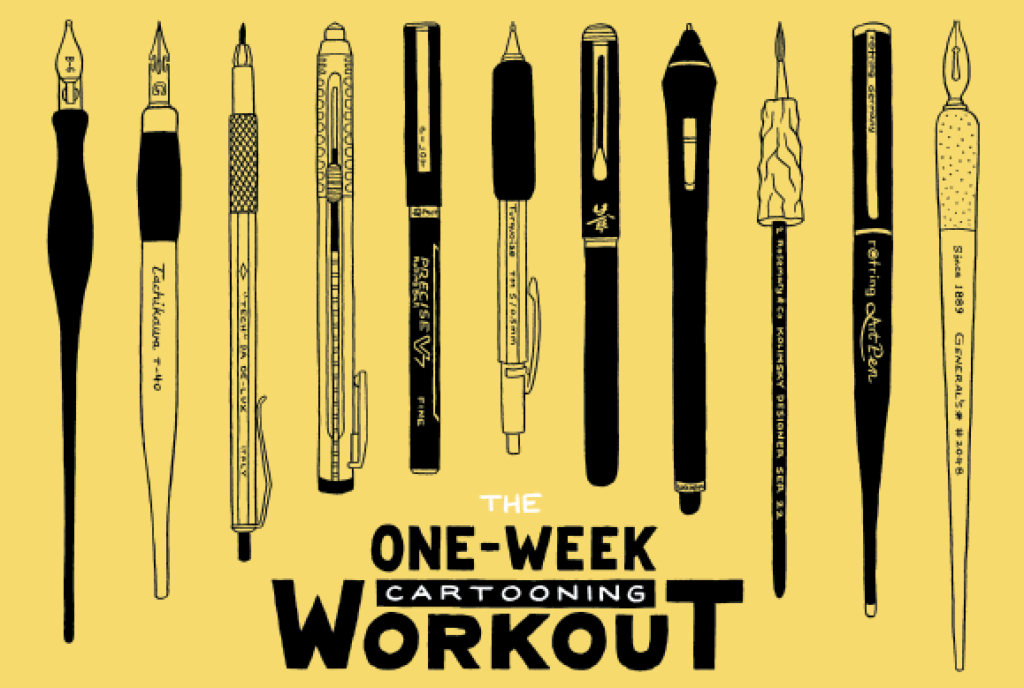
A free self-directed eCourse to improve your cartooning skills. Online, Start Anytime !
THE ED KOREN SCHOLARSHIP FUND
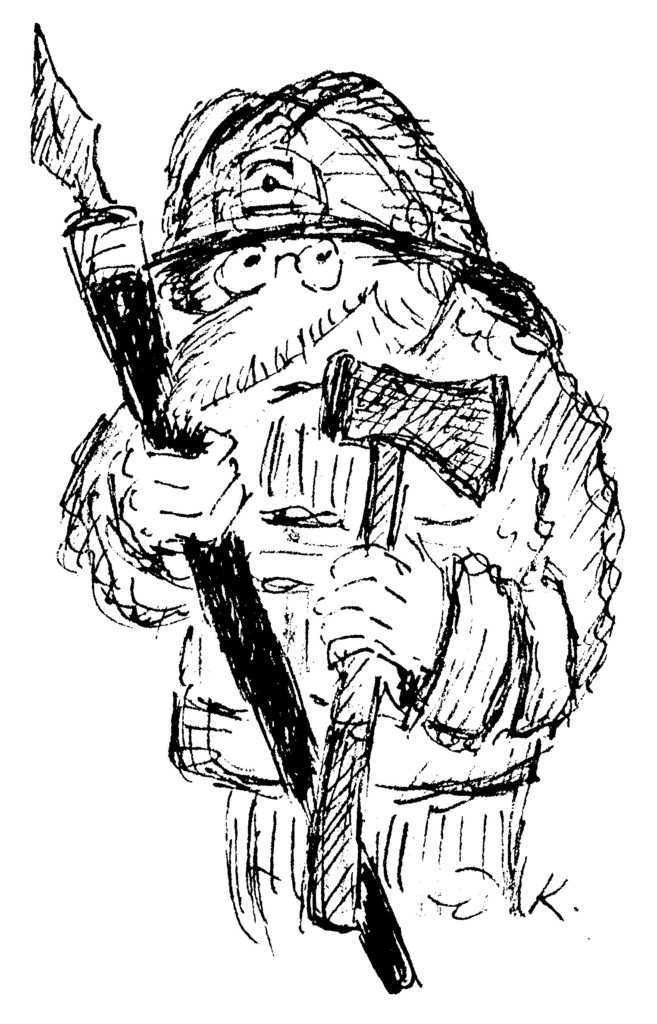
Click here to learn more and make an online donation now.
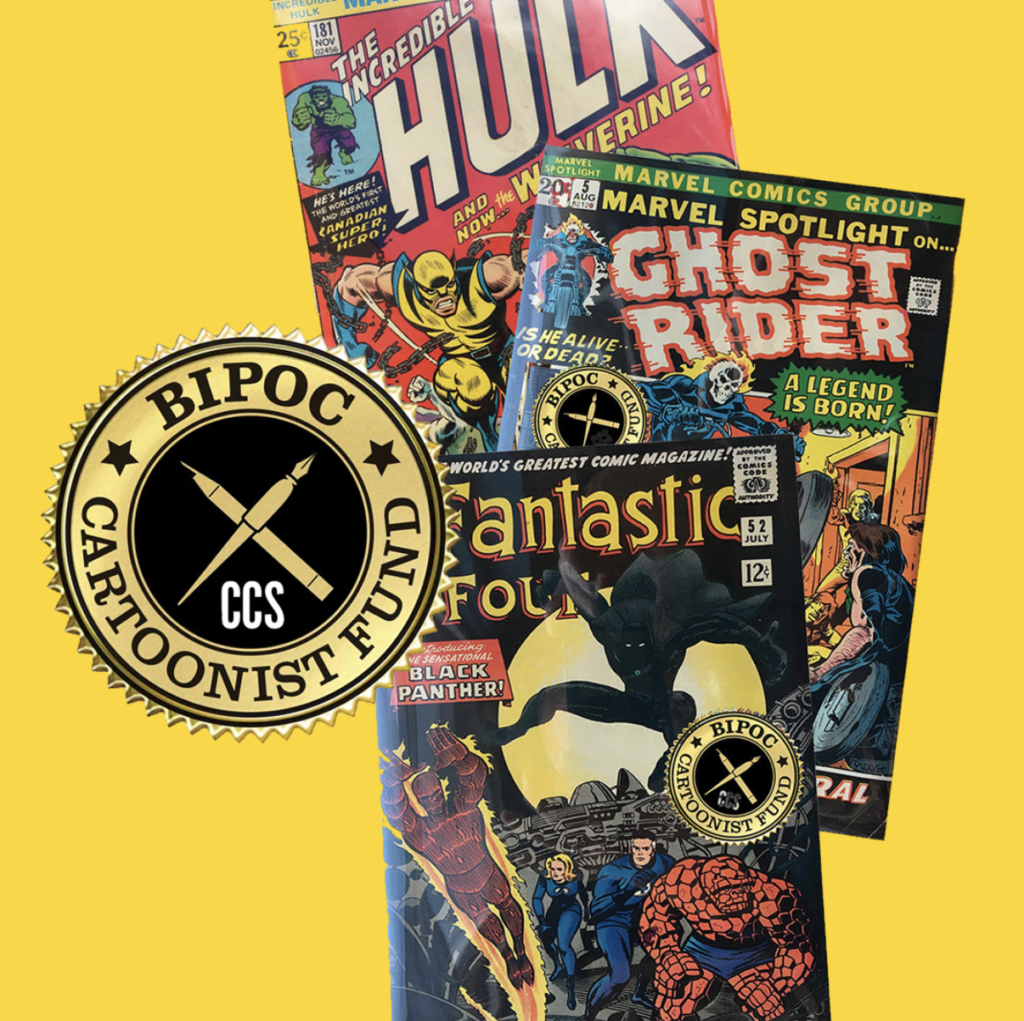
BIPOC Cartoonist Fund Accepting Donations
CCS wants your old comics! These comics and many more were donated to support CCS's BIPOC Cartoonist Fund. If you're interested in making a comic book or cash donation drop us a line .
FREE COMICS
Cartooning in an anxious age.
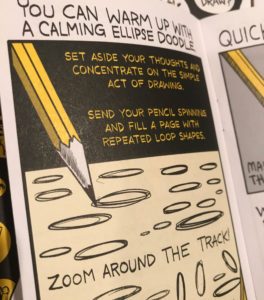
Cartooning In An Anxious Age (pdf) is a free comic by Cara Bean on the act of drawing, which focuses your attention and intimately connects you with the generative act of creation. It’s an inspiring read.
Let's Talk About It: A Graphic Guide to Mental Health
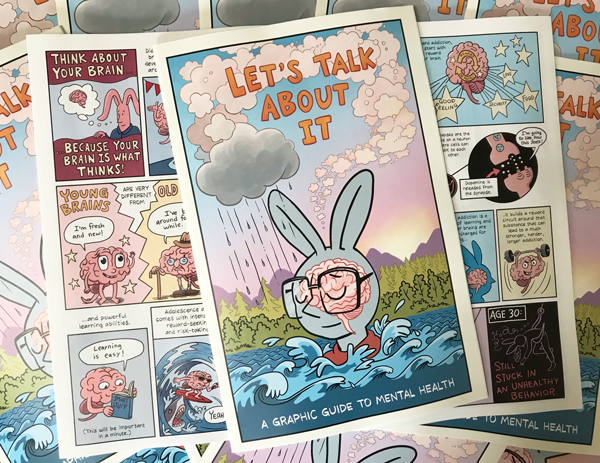
Created for middle and high school students, Let’s Talk About It: A Graphic Guide To Mental Health is a lively and educational comic book that destigmatizes the conversation around mental health.
A 32-page comic on how our government works
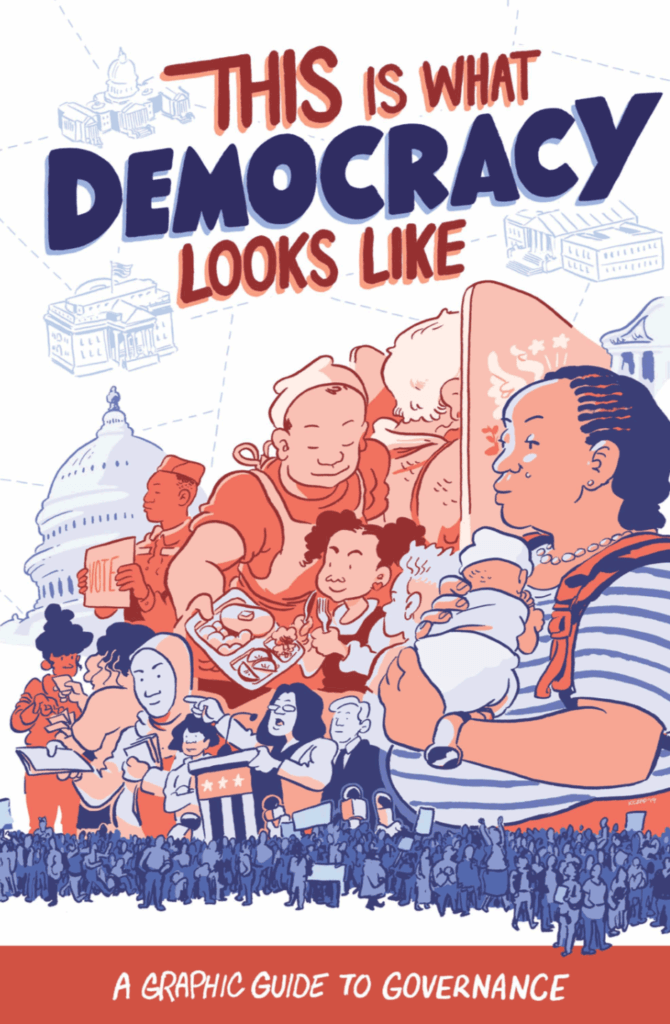
Using the power of comics to teach teens about the way our government works This Is What Democracy Looks Like, A Graphic Guide To Governance is a 32-page comic book created by The Center for Cartoon Studies (CCS). This short comic guide helps to bring democracy back to the hands of the people by explaining what democracy actually means and how the whole thing works. This guide will be a great jumping-off point to learn about our government.
- Lesson Plans
The Applied Cartooning Manifesto
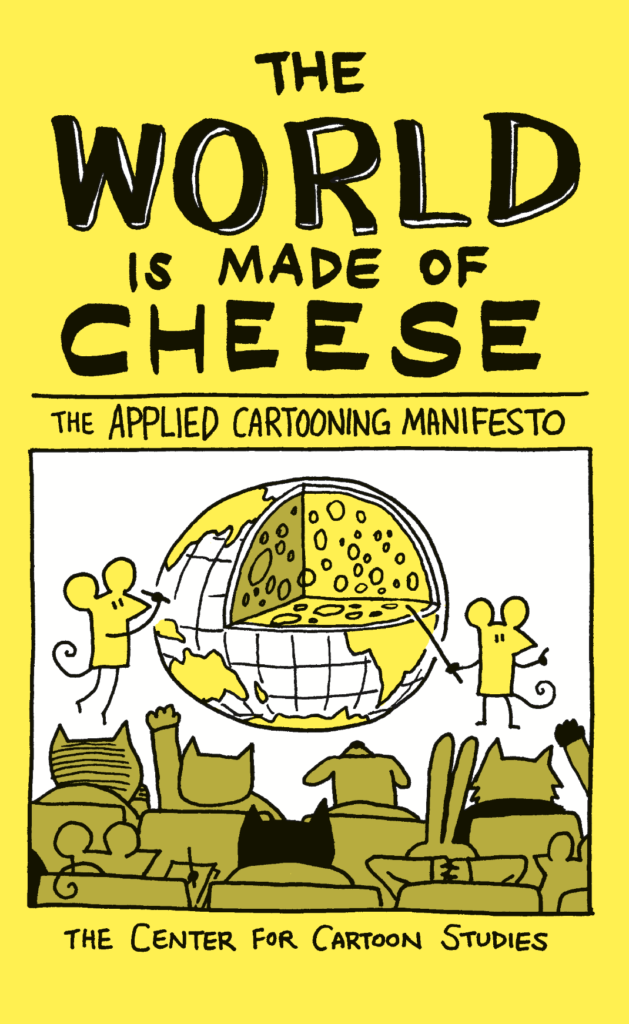
Download a free copy of The World is Made of Cheese, The Applied Cartooning Manifesto.

© The Center for Cartoon Studies PO BOX 125, White River Junction, Vermont 05001 [email protected] 802.295.3319
Comic Strip Template Pages for Creative Assignments

- Easel Activity
What educators are saying
Description.
Comic Strip Template Pages for Creative Assignments (Includes DIGITAL Version!)
Use these comic strip page templates for creative assignments for your students. They can be used to assign comic/cartoon strips about the unit you are studying, a biography of an author or historical figure, or a creative book report. This download includes 30 total templates .
Can be used with interactive notebooks, as well!
NEWLY UPDATED to include a Google Slides version! Just click on the link in the PDF to make a copy to your Google Drive.
PLEASE NOTE: THESE ARE *NOT* FOR COMMERCIAL USE. If you wish to use these templates in a product, you may purchase them in this bundle, which gives you a license to use them--along with hundreds of additional templates and clip art--in any product forever:
Interactive Notebook Templates and Shapes Bundle {Commercial Use Allowed}
Created by Tracee Orman
Mrs. Orman's Classroom
You might like these products:
Creative Activities for ANY Novel/Book or Informational Reading
ALL of my INTERACTIVE NOTEBOOK RESOURCES MEGA BUNDLE
Teacher Binder: Grade Book, Lesson Plan Forms, Sub Plans, Calendar, and More
Common Core Informative and Explanatory Writing Bundle
No Cutting FLIP BOOK for Interactive Notebooks
Editable Creative Questions for Any Book, Story, or Play
New Year Growth Mindset and Creative Activities
ALL of my READING RESOURCES MEGA BUNDLE
By the Waters of Babylon Short Story Unit
ALL of my BELL RINGER AND EXIT SLIP RESOURCES MEGA BUNDLE
Questions & Answers
Tracee orman.
- We're hiring
- Help & FAQ
- Privacy policy
- Student privacy
- Terms of service
- Tell us what you think

Share this post
5 reasons to try a comic strips activity .
- April 20, 2022
Looking for a creative project idea for your students? Try a comic strips activity in your classroom. With a comic strip activity, you can help students sequence events as they retell the steps for a science experiment, learn about graphic novels as a choice for independent reading, and start to think about whether they prefer to share in digital or print formats.
In today’s blog post, I share five reasons to try a comic strip activity. And I have a free download for you — 15 ready-to-use comic strips templates for your next lesson.
Let’s jump into the list of five reasons to try a comic strip activity!

Why Try a Comic Strips Activity
Practice sequencing skills.
A comic strip tells a story from beginning to end. It is a fantastic option for any activity where you want students to practice sequencing skills. Students can retell the events leading up to a critical historical moment or retell what happened in a story they read.
You might provide a list of temporal words for students to use, like: First, Then, Later, Next, Finally . Or you might share examples of comics that use this type of language in the caption. One reason to try out a comic strip activity with students is to help them practice sequencing – which can connect to any subject area.
Create an authentic product
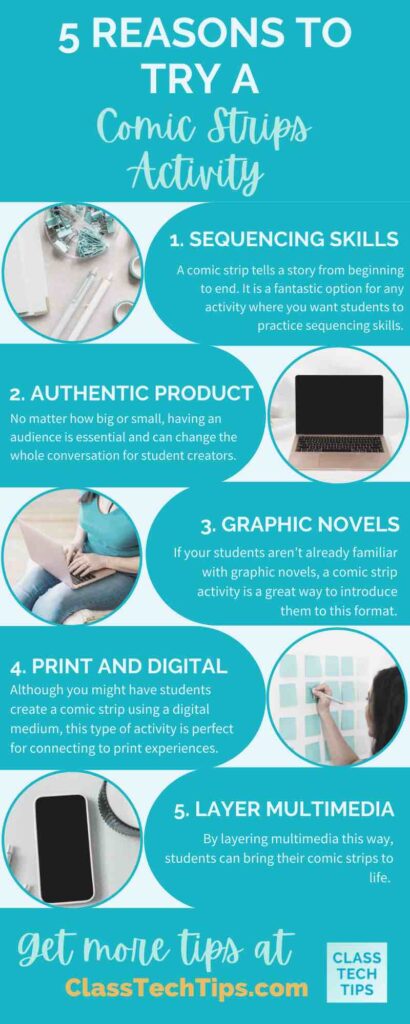
Late last year, I gave a keynote to about 750 educators in Wisconsin to kick off the SLATE Conference. During the keynote, I spoke about the students as creators, and I shared a clip from a podcast episode I had listened to earlier that month. The clip included an interview with Jeff Kinney, the author of the Diary of a Wimpy Kid series . This episode of the podcast, The Press Box , was all about his origin story and how he became a writer. And when the host asked him about this, Jeff Kinney said: “I always had that decision to make every day, which was should I do this term paper? That will be seen by my one professor. Or should I do my comic? Which will be seen by 30,000 people. And my grades really suffered, but I cut my teeth.”
Now I’m not saying students need to have an audience of 30,000 or 3,000 or even 300 to make their work special. But, no matter how big or small, having an audience is essential and can change the whole conversation for student creators. So one reason to consider using comic strips with students is to connect them to an audience that will celebrate their work.
Pique interest in graphic novels
If your students aren’t already familiar with graphic novels, a comic strip activity is a great way to introduce them to this format. Your primary purpose for a comic strip project could be to get students excited about the idea of reading comics. Students who aren’t super motivated as independent readers might be more willing to give graphic novels a chance after making their own comic.
You might decide to reach out to a media specialist in your school or a librarian in your community. If you’re not familiar with graphic novels or are teaching a subject area like math or science, this person could serve as a resource for recommendations of graphic novels.
Connect print and digital experiences
Although you might have students create a comic strip using a digital medium, this type of activity is perfect for connecting to print experiences. For example, students can explore graphic novels in paperback format or comics from a newspaper. You might provide the option for students to create a comic strip on paper or with digital tools. This is a great way to show students that both online and offline experiences have value, and there are plenty of ways to express themselves — both with or without digital tools .
Layer multimedia

Students can share their comics in many different ways. One fun option is to use the green screen option in Flipgrid . Students can save their comic strip as an image and add it to the background of a Flipgrid response. By layering multimedia this way, students can bring their comic strips to life. They might read it aloud with emotion and expression or share the story behind what they created.
If you want to try out a comic strip activity with students, check out these free templates I made. It also includes instructions on how to make your own comic templates for students. Click here to download the ready-to-use comic strip templates .
Stay up-to-date on all things EdTech.
EdTech tips and resources for educators, straight from Monica’s desk every Monday. Don’t miss a thing.
Share this post:

Monica Burns
Dr. Monica Burns is a former classroom teacher, Author, Speaker, and Curriculum & EdTech Consultant. Visit her site ClassTechTips.com for more ideas on how to become a tech-savvy teacher.

How to Create Calm in Your Classroom with Meredith McNerney – Easy EdTech Podcast 262
Join Meredith McNerney as we explore how to create calm in your classroom! Discover practical strategies for your daily routines.

AI and The Power of Play – Bonus Episode with Activ8
Discover how AI revolutionizes play-based learning! Join CEO Mike McDonald as he shares innovative ideas for embracing the power of play.

5 Ways to Use Interactive Video with Students
Explore WeVideo and how to use interactive video to transform create an interactive, engaging learning journey with self-paced instruction.

Start every week with a plan and stay organized this school year!
- You'll get a standard daily planner template, weekday, and weekend templates
- A monthly at-a-glance calendar and a monthly goal setting sheet
- A few extra pages for notes, contacts and passwords
Free summer Checklist

5 Things to Do Now to Make Tech Easier in the New School Year
- Try these five tips now and save time when you head back to school this fall.
- This quick list gives you FIVE action items to make your technology integration easier this school year.
- Save time this school year with a special EdTech checklist

Spring Cleaning with an EdTech twist!
- Special eBook with 10 Quick Tips to Organize Your Google Drive
- If you're not using Google Drive, these strategies are customizable for Dropbox, Office365 and more!
- Get a fresh start this spring with these actionable tips for cleaning up your online organizational systems
Are you an EdTech company interested in getting featured on Class Tech Tips? Email [email protected]
Free planning pages, free summer checklist, spring cleaning guide, free - 10 quick tips to organize your google drive.
5 fun ways to use blank comic strip templates in your class
by mindroar | May 8, 2023 | blog | 0 comments
Today we’re looking at five fun ways to use blank comic strip templates in your class.
Picture this. It’s 3.05 on a Wednesday afternoon. You have to finish work, get to your kid’s daycare, wrestle them into a car seat, and take them to a doctor’s appointment.
You have to be there at 3.45pm. You have 10 minutes to plan for tomorrow’s lessons.
You’d also like to give your students a chance to be creative. Because you know they’re sick of chalk and talk. You know they’re sick of taking notes. And you know they’re sick of five minute videos followed by a worksheet.
So what can you do? My suggestion, use blank comic strip templates in your class. How? There are lots of fun, easy, engaging ways to use blank comic book templates in your class. Today we’re going to look at five.
Blank comic strip template activity idea #1
You can use blank comic strip templates to get students to recount events or summarize. information.
For example, in ELA you can get students to review chapters of a novel or short stories. Or, they can show character information.
You can also get students to transform a text. For example, you could get them to change a poem, short story, or news article into a comic strip.
Using a blank comic strip in this way gives students the chance to be creative, but also to demonstrate their understanding of the events, characters, and other aspects of a text.
In Social Studies, you can get students to do something similar and recount the series of events leading up to a major historical event or geographical phenomena.
Again, students get to show their understanding in a creative way and you get a quick, low-prep activity that students will engage with more than writing notes.
Activity idea #2
You can use blank comic strip templates to get students to recount or plan a process.
For example, in a science lesson, students could use a blank comic strip template to either recount or plan a scientific experiment.
This is great for students who have low written ability, because they can still show their understanding of the process without having to write out tons and tons of words.
Alternatively, if your student’s written ability is stronger, this is a great way for students to plan what they need to do, and then use that blank comic strip template to as a guide for when they’re writing their lab report..
You could use it in a similar way in hospitality or cooking. Students could use blank comic strip templates to write a recipe or create the mise en place for a multicourse meal.
Again, this is great for students who are slow writers or have low literacy because they can get their ideas down on paper without having to think of the words..
Blank comic strip template activity idea #3
Students can use a blank comic books template to plan a story or video
In ELA, students could use this to plan a short story or some other kind of creative writing.
Using a comic strip template would have an advantage over something like brainstorming, particularly for something like descriptive writing. That’s because in descriptive writing, students are wanting to give their reader a visual image in the readers mind.
And it’s far easier to do that by drawing pictures and using detail in the picture to plan what you’re going to write about rather than trying to write straight away.
In a subject such as media studies, students could use a blank comic strip template to plan a video with each box on the template representing one scene within a video.
This would cut down on the amount of time students would need to film and give them more time to edit their work.
Activity idea #4
You can also use a blank comic strip template as a one-pager assignment. What is a one pager assignment? Basically a one-pager assignment is a task that gets all the work done on one page.
Examples of one-pager assignments in ELA include ideas such as illustrated character biographies, creating a scene from a ‘silenced’ character, or writing the ‘backstory’ of a character that helps explain their motivations at a particular point in a text.
You can use one-pager assignments as an alternative to an essay or other analytical tasks. But that doesn’t mean that it’s not intellectually rigorous.
A one-pager assignment can be just as intellectually rigorous as a written assignment. This is especially true if students are needing to recall or explain details for aspects of the text such as character development, literary devices, the plot of the story, important quotes, or major themes within the text.
And if students are doing that all on one page, they’re still going to be creating a rigorous assessment piece. Even better, students can do a one pager on a book, but also a variety of other text types, such as a poem, a short story, or a visual text.
On top of that, one pager assignments gives creative students a chance to shine and lower-literacy students the chance to demonstrate their knowledge in a way that doesn’t rely solely on their written ability.
Blank comic strip template activity idea #5
Finally, students can use a blank comic strip template to analyze or empathize with characters in a story. This could follow a similar set up to a one pager novel project, where students put their entire assessment on just one page.
One ways students can do that is to show why a character does something in a text. This type of task shows students’ inferential skills because it shows that students are thinking about why a character might be motivated to behave in a specific way.
Another option, where students can show their understanding of a character is to either create or explain a character’s backstory. Creating a backstory shows that students are having to notice details about a character and then use that within their comic strip assignment.
Another option is to ask students to create a prequel or sequel to scene for a text. Both of these enable a student to show you what they think about the characters without having to do a ton of writing.
Creating a prequel or a sequel scene for a text is showing students’ understanding of character development. This is because they have to show why the character has behaved in a certain way within a text.
Creating a backstory in a prequel scene enables students to infer what has happened before the text to make that character the way that they are.
And making a sequel scene for a text enables students to explain how the events in the story have changed the character in some way. By using a sequel scene, students can explain character development by showing the character behaving in a way that demonstrates their growth.
These are only a few starter ideas
These are just five fast, fun, easy, engaging ways to get your students to do something other than take notes or do worksheets. And they are just the begining.
One of the great things about blank comic strip templates is that they’re so versatile and can be used in many different ways, in many different subject areas, with students of different ages and abilities.
So you can plan your lessons quickly and make it to your kid’s doctor appointment on time without having to spend hours planning a lesson after your kid is asleep.
Because let’s face it, you’d rather be watching Netflix or escaping into that novel beckoning from your beside table.
Keen to try it out?
If you want a little one pager inspiration, click here for a free blank comic strip printable template you can use in class.
Love that freebie and want more?
Check out this blank comic strip printable template bundle with multiple comic strip formats.
Other blog posts that may interest you
- Worried about teaching Shakespeare? How to make it fun + easy
- 8 awesome reasons to focus on study skills in ELA
- 13 easy, engaging lessons for Romeo and Juliet
- 20 exciting and engaging lessons for To Kill a Mockingbird
- 19 activities for teaching The Odyssey: a comprehensive list
- International
- Schools directory
- Resources Jobs Schools directory News Search

Canva - Create a Comic Strip - Assignment for Students
Subject: Computing
Age range: 11-14
Resource type: Lesson (complete)
Last updated
11 February 2023
- Share through email
- Share through twitter
- Share through linkedin
- Share through facebook
- Share through pinterest

Introduce your students to the world of digital storytelling with this engaging and educational assignment. With the rise of visual storytelling, comic strips have become an increasingly popular form of communication, and this project will give your students the opportunity to create their own comic strip using Canva.
In this assignment, students will:
- Create a Canva account if required
- Choose a comic strip template
- Customize the template with their own images, characters, and text
- Add dialogue to bring their story to life
- Rearrange panels to create the desired layout
- Proofread their comic strip to ensure accuracy and clarity
- Download or share their final product
This assignment is designed to be easy to follow, with student instructions and a grading rubric to help you evaluate your students’ work. Whether you’re a seasoned Canva user or new to the platform, you’ll find that this assignment is a fun and accessible way for your students to express their creativity and practice their digital skills.
- Student Assignment in pdf (planner, instructions, shortcut keys, examples)
- Grading rubric provide in word and pdf
- Planner provided in word and pdf
So why wait? Give your students the gift of storytelling and get them started on their own comic strip today!
Just deliver the pdf with instructions, shortcuts keys and examples to them either electronically or by print. You will need an internet connect so that students can use the Free or Education account in Canva to complete this lesson.
If you have any questions about this resource please contact me at [email protected] .
Tes paid licence How can I reuse this?
Your rating is required to reflect your happiness.
It's good to leave some feedback.
Something went wrong, please try again later.
This resource hasn't been reviewed yet
To ensure quality for our reviews, only customers who have purchased this resource can review it
Report this resource to let us know if it violates our terms and conditions. Our customer service team will review your report and will be in touch.
Not quite what you were looking for? Search by keyword to find the right resource:
- Book Lists by Age
- Book Lists by Category
- Reading Resources
- Language & Speech
- Raise a Reader Blog
- Back to School
- Success Guides by Grade
- Homework Help
- Social & Emotional Learning
- Activities for Kids
Create Your Own Comic Strip: A Printable Template
Your kids can combine creativity and writing by filling in these blank comic strips with their own unique stories and illustrations..

Shop Comics & Graphic Novels
- My Storyboards
Water Cycle Narrative: Create a Comic Strip
In this activity, activity overview, template and class instructions, more storyboard that activities.
- This Activity is Part of Many Teacher Guides

One really fun and creative way for students to master the water cycle is to create a narrative! In this activity, students will tell the story of a water droplet going through the water cycle. It is important that students include the role of the Sun and gravity in their narrative storyboards. Students may start their narrative at any point in the water cycle.
You can modify this activity by giving students a copy of the water cycle diagram, or provide them with an edited copy of the example storyboard above that has images or text on it already.
(These instructions are completely customizable. After clicking "Copy Activity", update the instructions on the Edit Tab of the assignment.)
Student Instructions
Demonstrate your understanding of the water cycle by creating a narrative storyboard. Tell the story of a water droplet and explain what happens as the droplet moves through the water cycle, including how the water cycle is driven by energy from the Sun and the force of gravity. You can choose which part of the water cycle you want to start with.
- Click "Start Assignment".
- Create your narrative in the description boxes. Allow one cell for each step.
- Create an illustration for each using appropriate scenes, characters, items, etc.
- Search "face" for different facial expressions.
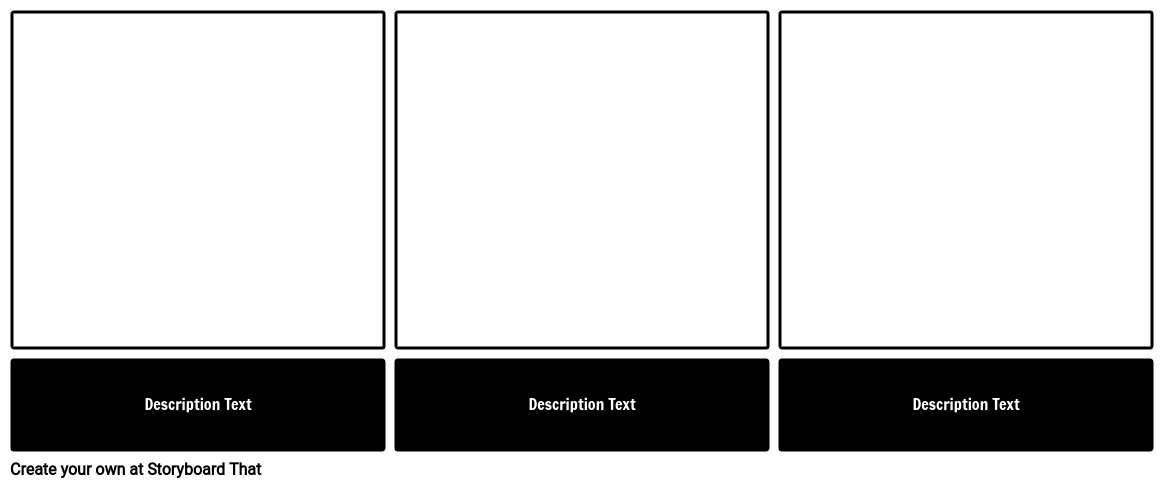
Lesson Plan Reference
Grade Level 3-4
Difficulty Level 4 (Difficult / Complex)
Type of Assignment Individual
- [SCI-4-ESS2-2] Analyze and interpret data from maps to describe patterns of Earth’s features.
(You can also create your own on Quick Rubric .)
Water Cycle
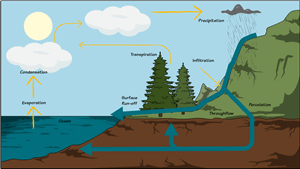
Try 1 Month For
30 Day Money Back Guarantee New Customers Only Full Price After Introductory Offer
Learn more about our Department, School, and District packages

- Thousands of images
- Custom layouts, scenes, characters
- And so much more!!
Create a Storyboard

Weird, Unsocialized Homeschoolers
Honest. Quirky. Real. Stereotype-smashing humor for homeschooling families.
Creative Ways to Use Comic Strips in High School Literature
Did you like this article? If so, please help by sharing it!
- Facebook 14
- Pinterest 7
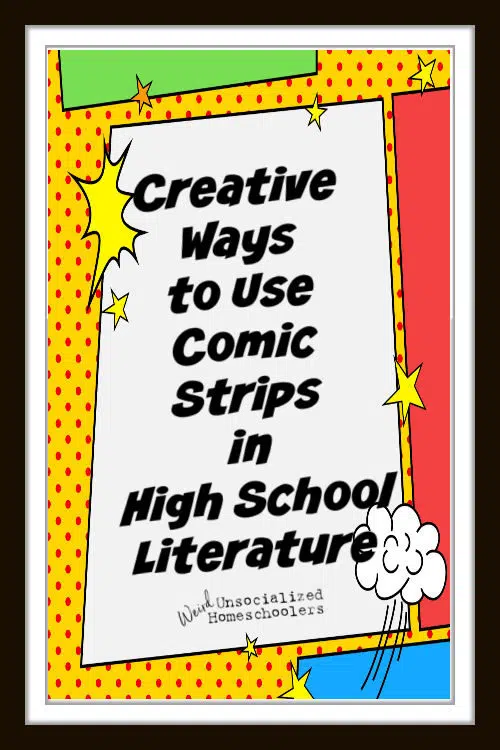
Ways to Use Comic Strips in High School Literature
Comic strips sometimes have a reputation for being less-than-literature, but the reality is that they offer a very unique mode of storytelling that kids and teens are naturally drawn towards.
Today I’m sharing a secret weapon for teaching literature that – especially if you have middle- or high-school-aged students – is going to be a game-changer. And by now you’ve guessed what it is. (Gee, did the title give it away?) Comic strips!
Comic strips are a super-effective, cheap, and fun tool that you can use to make high school English/literature extra creative, fun, and engaging.
While you can definitely use published/written comic books in your English or literature class (there are even some classic works of literature that have been re-imagined in that format ), that’s not what this article is about.
Instead, I’m talking about getting older kids and teens to create their own comics. There are several ways to use comic strips in high school literature to make difficult material easier to understand and a lot more fun, too.
Why Comics Help
There are several reasons it can be a good idea to utilize comics with your homeschooled high schoolers. And (confession time) I think these strategies can be just as helpful with younger kids, too. And if you think that older kids or teens won’t like this kind of thing—it’s just not true! Even adults can use comic doodles to make sense of complicated material.
Here are a few reasons I think comic strips can be a powerful superweapon, particularly for older kids and teens.
1. They’re familiar and low-pressure.
Comic strips are a much more laid-back format for expression than some of the more standard forms of high school-level assessment. Why add extra intimidation, particularly if your student happens to get overwhelmed by a particular subject (like literature or English)?
For example, if you have a student who has trouble writing summaries, you may want to use comic strips to guide the summaries instead. Alternatively, you could add comic strips as an assignment in between reading and writing a more formal report. That way, students can use their completed comics as guidelines for more formally-written work. Comic strips can be a low-pressure way for students to organize their thoughts.

2. They’re so much fun, you don’t realize how much you have to think about them.
Comics, by nature, are super-condensed reflections of insight/understanding. You know what they say: “If you want to learn something, figure out how to teach it.” Creating comics is kind of the same deal. You have to understand something really well in order to be able to creatively summarize it in a small space. So even though teens will enjoy the creativity of using comics in their study of English or literature, they will still be effectively challenged, too!
3. Creativity inspires ownership of learning.
Personally, I’m a big believer in utilizing creativity as much as possible in homeschooling (and in life in general!) One reason is that we always learn from creating. We also typically feel pride, ownership, and connection with the things that we create.
When students get to create something as part of their learning experience, they gain a sense of ownership over the things they’ve learned, too! This may have even more impact on teens, who are in a constant process of gaining responsibility, independence, and ownership over their own opinions.
What better time to embrace assignments that nurture creative expression? As a homeschooling alum, I know that educational moments that I remember the most from my homeschooling years were tied to assignments in which I got to apply my learning in a creative way.
A Few Ways to Use Comics in English/Literature
Here are some specific ways you can get your high schooler using comic strips to help make English or literature more fun and accessible! There are endless possibilities, but here are a few of the methods I love.
1. Use comics to illustrate a grammatical concept.
The next time you introduce a new concept in grammar, get your homeschoolers to see if they can think of some real-life examples and turn those examples into comics! This requires your students to understand the concept well enough to “tell a story” with it. However, they will have so much fun being creative that it will seem more like an engaging challenge than an assignment.
In the picture below, the concept is that of the double negative. When the boy says, “I swear I didn’t not do it!” he accidentally says the opposite of what he means to say.
You could use this idea to explore almost any grammatical concept: from prepositions to pronouns to run-on sentences! (Don’t forget to give extra points if it’s funny!)
2. Comics can bring a literary device to life.
Similarly, use comic strips to bring literary devices to life (and make them more fun too)!
These concepts beg for solid examples in order to be properly understood! If you are studying literary devices with your student, you may even want to have him/her create a comic for each one and keep it in a book. Things like metaphors, similes, alliteration, and foreshadowing are much easier to understand when you have a story and image to go with them!
You can get some inspiration on these sites:
- Read this article on mikekerr.com for examples of funny similes and metaphors .
- Learn all about alliteration (See what I did there?) and read some fun examples at Alliteration Examples for Kids . (They work for teens too!)
- And take a look at these great explanations and examples of foreshadowing .
3. Comics make great visual organizers for note-taking or creative writing planning.
Use the boxy format and doodling space of comic strips for a unique type of note-taking space that your student will actually want to use! (This is particularly great if you’ve got a visual learner.)
Are you trying to help your student consistently recognize elements of a story (plot, characters, setting, conflict, and resolution)? Comics can help.
Your students could keep up with each chapter of a book this way. Or they could even plan out their own short stories using this hybrid form of doodling/note-taking. (P.S. Especially if used to keep track of works of literature, this helps tremendously for stories with a lot of characters or confusing character names).
4. Comics can be used as an alternative for a book summary (or even a persuasive essay).
There are a lot of ways to use comic strips in high school literature as an alternative to a larger project, such as a traditional book report or persuasive literary essay.
For example, your homeschooler could:
- Use several pages to create an original, illustrated summary of the work of literature.
- Create different sections for characters and possible themes (as shown below for A Midsummer Night’s Dream ). Then, he or she could choose to expand on each theme, choosing sections from the work to illustrate in defense of that point (just like in a persuasive essay, but visual).
- Choose favorite quotes from a particular work to illustrate or re-create as a comic strip scene.
There are so many options, and -honestly- all of them are pretty fun!
I hope this gives you some simple ideas about how you can start using comic strips to teach English or literature with your older child or high schooler!
By the way, you can CLICK HERE to go to an article on our sister site, Only Passionate Curiosity, to download your own comic strip book report template to use with your kids and teens! You’ll also find ideas for how to use the templates.
What do you think about these ways to use comic strips in high school literature? Will you give comic strips a try with your older homeschooler? Let me know what you think or share your own ideas for creative ways to use comic strips!
You May Also Like
Comic Strip Book Report Template for Kids and Teens
5 Easy Ways to Bring Books to Life
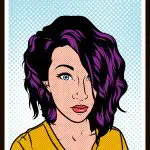
Katie Gustafson has been a member of the world of “weird, unsocialized homeschoolers” for a long time–first as an alumnus and now as a homeschooling mom to a fiercely fun little girl! She’s very into anything creative, especially writing, dancing, and painting. She’s also particularly passionate about literature and owns more books than she will probably ever be able to read. However, she reassures herself with the belief that, in the event of a digital apocalypse, she’s cultivating a much-needed physical library for future generations. Katie is happy to contribute articles to Weird Unsocialized Homeschoolers, Hip Homeschool Moms and Sparketh . She also has a personal blog on writewhereuare.com .
- Kathryn https://www.weirdunsocializedhomeschoolers.com/author/kathryn-gustafson/ Make this Whimsical The Cat in the Hat Diorama to Celebrate Dr. Suess Day!
- Kathryn https://www.weirdunsocializedhomeschoolers.com/author/kathryn-gustafson/ Who's Helping You Homeschool? 10 Places to Find Support
- Kathryn https://www.weirdunsocializedhomeschoolers.com/author/kathryn-gustafson/ 5 Lessons for Homeschooling in Tough Seasons
- Kathryn https://www.weirdunsocializedhomeschoolers.com/author/kathryn-gustafson/ 30+ Gift Ideas for Moms Who Homeschool
Leave a Reply Cancel reply
Your email address will not be published. Required fields are marked *
Notify me via e-mail if anyone answers my comment.
This site uses Akismet to reduce spam. Learn how your comment data is processed .

Exploring Writing Through Comics
Pairing Images with Words
Jason DeHart
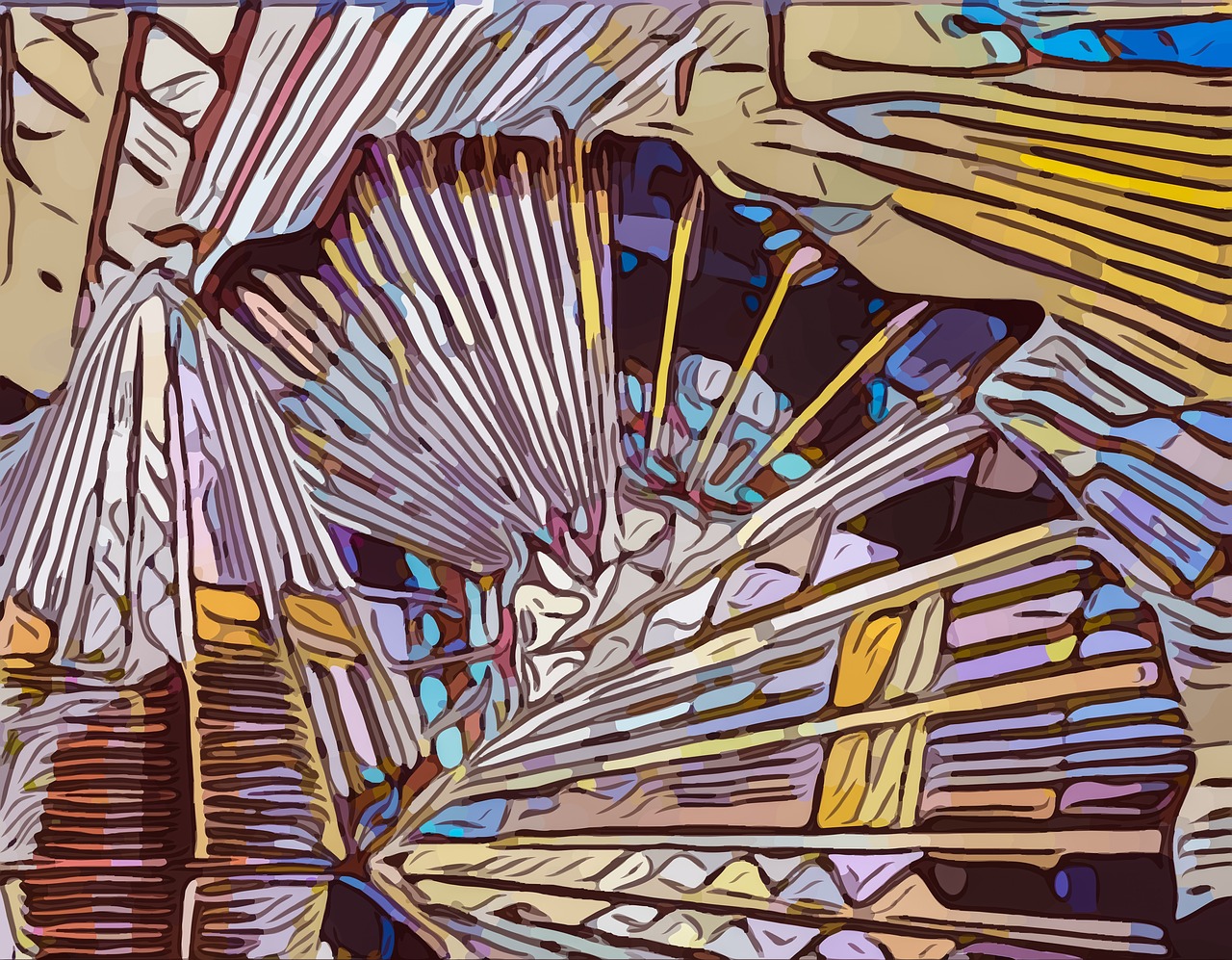
In my experience as a middle school teacher, I often found that some students were hesitant to engage with the written page, either as readers or writers. On the other hand, colorful characters and even segments from popular superhero movies were almost always uniquely engaging for students. Comic books and heroic characters made regular appearances in my classroom, and my students even made their own comics.
Comic books work by pairing images with words in a way that can be visually intriguing, while inviting students into a reading experience. Moreover, comic books often feature characters from popular films and television shows, creating an additional media connection for students. Sometimes in my classes, making comics was an introduction to a concept; other times moving ideas into the physical space of comic book panels was a creative way of reviewing material. Grammar concepts, as well as concepts of composition—including mood, tone, and dialogue— could be worked into a comic strip. What follows is a brief lesson plan outline for a three-day unit using student-created comic strips to review concepts of character and plot.
Day One: The Planning Phase
Begin working with students so that everyone has a meaningful role in developing the comic strip. Each student should be involved in the planning, the writing, and the design phases. This activity took a variety of shapes in my classroom, from individual to collaborative work—I usually organized the activity as a small group assignment where students worked together to produce one comic book/comic strip product. This allowed for team work, creative engagement, and dialogue about the process. I typically introduced the activity with a brief model for the entire class before splitting the students into groups.
On the first day of this teaching segment, briefly review character development and plot structure with students. This can be done very efficiently with graphic organizers, including character webs and plot diagrams. These simple visuals are freely available in a wide variety of places on the Internet, including Read Write Think .
Have students choose elements to include in their comic strips, including characters, attributes of these characters, special powers, and a central conflict that can drive the narrative. This step can be quite creative and allows students to begin to feel like writers as they make choices about their work.
Day Two: The Writing Phase
Once students have made decisions about the elements to include in their comic strips, day two begins the writing phase. Remind students about the structure of plots and how characters work. Consider posting visual reminders around the room so students can reference them as they work.
Each student should be involved in the process of writing the narrative. In fact, I always like seeing multiple examples of handwriting on the page so I know the students are working collaboratively. Writing can focus on developing a script that includes where the story takes place and how the plot develops over time, including conflicts. Students can also include a sense of the dialogue in the story, outlining what the characters will say to one another in the final product.
Day Three: The Design Phase
The final part of the process is actually translating the script and narrative into a comic strip. This can be done by providing a large poster board or individual pages that have been folded and marked to form panels. Students will be making decisions about how to adapt their scripts and narrative writing documents visually. Sometimes this involves decisions about what to cut, what to keep for the final product, and the best way to show details in panels. The process should be collaborative throughout, and all students should have a voice in deciding how to adapt their ideas into images.
Conclusions and Accommodations
The middle schoolers who found their way into my English/Language Arts class were almost always very well engaged by the comic strip activity. Over time, I learned the best way to implement this plan was by exploring large-format comic strips on chart paper, and then ultimately settling on smaller page formats. I also found that the activity was much more successful as a group process, with the exception of a small number of students who were already interested in comics and comic book creation. The groups often had two to three students, although this grouping could increase or decrease depending on the needs of students and the teacher’s observations about how well all members are included in the process. Sometimes I provided character names, but often students enjoyed coming up with their own. In most cases, they designed a protagonist, a sidekick as a support figure, and an antagonist.
When space allowed, students enjoyed spreading out and designing their work on larger pages. This allowed more access for all group members. Small pages were useful as well, but involved additional planning. Group members would then assemble the individual sections into side-stapled, student-created books.
Additional time may be allowed for any part of the process: for expanding the unit should students require more time, or for accommodating the class time allowed for the activity. I would also recommend a variety of mentor texts that demonstrate the nature of the comic book/graphic novel format. The work of Doug TenNapel (especially Ghostopolis ) comes to mind, as well as the graphic novel adaptations of A Wrinkle in Time by Madeleine L’Engle and Coraline by Neil Gaiman . Also , Black Panther: World of Wakanda by Ta-Nehisi Coates and Roxane Gay is a high-quality choice from two writers who are exploring new genres and media. As part of exploring the world of comic books and graphic novels, this provides the added benefit of expanding the classroom library.

Jason DeHart is a PhD candidate in literacy studies at The University of Tennessee, Knoxville. DeHart has worked in the education profession for over a decade, and taught 8th-grade language arts at Ocoee Middle School in Cleveland, Tennessee.
Related Posts

<strong data-cart-timer="" role="text"></strong>
Flickr user Gonzalo Díaz Fornaro, Creative Commons
- Visual Arts
- Drawing & Painting
Creating Comic Strips How can you weave together words and pictures in a comic strip to create a nonfiction story?
In this 3-5 lesson, students will examine comic strips as a form of fiction and nonfiction communication. Students will create original comic strips to convey mathematical concepts.
Get Printable Version Copy to Google Drive
Lesson Content
- Preparation
- Instruction
Learning Objectives
Students will:
- Analyze the evolution of comic strips using the familiar Peanuts comic strips and other comic strips.
- Explore comic strips from the perspective of a story (setting, characters, plot).
- Evaluate comic strips by looking at words, pictures, and how they work together.
- Create an original comic strip to convey mathematical information.
- Share original comic strips with younger students as a reference tool.
Standards Alignment
National Core Arts Standards National Core Arts Standards
VA:Cr1.2.3a Apply knowledge of available resources, tools, and technologies to investigate personal ideas through the art-making process.
VA:Cr1.2.4a Collaboratively set goals and create artwork that is meaningful and has purpose to the makers.
VA:Cr1.2.5a Identify and demonstrate diverse methods of artistic investigation to choose an approach for beginning a work of art.
Common Core State Standards Common Core State Standards
ELA-LITERACY.W.3.2 Write informative/explanatory texts to examine a topic and convey ideas and information clearly.
ELA-LITERACY.W.4.2 Write informative/explanatory texts to examine a topic and convey ideas and information clearly.
ELA-LITERACY.W.5.2 Write informative/explanatory texts to examine a topic and convey ideas and information clearly.
MATH.CONTENT.3.MD.A.2 Measure and estimate liquid volumes and masses of objects using standard units of grams (g), kilograms (kg), and liters (l).1 Add, subtract, multiply, or divide to solve one-step word problems involving masses or volumes that are given in the same units, e.g., by using drawings (such as a beaker with a measurement scale) to represent the problem.
MATH.CONTENT.4.MD.A.1 Know relative sizes of measurement units within one system of units including km, m, cm; kg, g; lb, oz.; l, ml; hr, min, sec. Within a single system of measurement, express measurements in a larger unit in terms of a smaller unit. Record measurement equivalents in a two-column table.
MATH.CONTENT.5.MD.A.1 Convert among different-sized standard measurement units within a given measurement system (e.g., convert 5 cm to 0.05 m), and use these conversions in solving multi-step, real world problems.
Recommended Student Materials
Editable Documents : Before sharing these resources with students, you must first save them to your Google account by opening them, and selecting “Make a copy” from the File menu. Check out Sharing Tips or Instructional Benefits when implementing Google Docs and Google Slides with students.
- Comic Strip Template
- Snoopy in Space
- Peanuts Motion Comics: Independence Day
- Early Peanuts Comics Strips
- Make Beliefs Comix
- Digital Storyboard Maker
Additional Materials
- Pencils, fine-tip markers or pens
Teacher Background
Teachers should review the lesson and standards. Math standards are suggested but not limited to the ones listed. Visit CCSS Math Standards for more information. Review the book, Comic Strips: Create Your Own Comic Strips from Start to Finish by Art Roche. Select a video from the Peanuts Collection or Snoopy Collection (example: Peanuts Independence Day ). Exploring the following resources is also helpful prior to teaching the lesson: Early Peanuts Comics Strips (1950-1968), age-appropriate comic strips , an example Math Comic Strip , the history of comic strips, and parts of a story.
Student Prerequisites
Students should be familiar with grade-level math and parts of a story (setting, characters, plot).
Accessibility Notes
Adapt math materials as needed and allow extra time for task completion.
- Show a Peanuts comic strip video, such as Snoopy in Space or Peanuts Motion Comics: Independence Da y .
- Prompt a class discussion with the following questions: Is this fiction or nonfiction? (It is creative nonfiction, using fictional characters to share factual information.) Who is familiar with the Peanuts characters? What other Peanuts shows have you seen? What story elements do you recognize? What is the goal of the production? What art technique is used to produce this video?
Build
- Explore the evolution of Early Peanuts Comics (1950-1968). Ask students: What similarities and differences do you notice about the comic strips? How many frames are used in each strip? What role does color play in creating these comic strips? Who created these comic strips? (Introduce the creator, Charles Schultz, to the class.)
- Discuss the history of comic strips. Share that comic strips have been used as a communications tool for over 100 years and the first successful daily comic strip was Mutt and Jeff , which started in 1907. Comic strips are used to tell a story. They have three main parts of a story: s etting, characters, and plot . Comic strips use words and pictures equally. Comic strips use a series of frames to show story movement.
- Explore age-appropriate comic strips . Have students work either independently, in groups, or as a class to explore other comic strips. Examine each comic strip for parts of a story, the use of words and pictures, and the number of frames used.
- Discuss the use of comic strips to convey factual information. Ask students: What factual information was shared in the comic strips or video we watched? What other factual information can be shared using a comic strip? Why would a comic strip creator want to share nonfiction information in this format?
- Create original comic strips using the Comic Strip Template or digital comic strips with sites like Make Beliefs Comix , Pixton , or Digital Storyboard Maker . Have each student create a 4-frame comic strip to convey a math concept. Model a math concept, then assign a math concept (learned or reinforced in the student’s previous grade) to each student. Using the three parts of a story, have each student create a comic strip to share the math concept. Have the student first work in pencil (drawing lightly). Review each comic strip draft for accuracy. Once approved, ask the student to “ink” the strip using a permanent fine tip marker. Erase any remaining pencil marks. Each student should title (top line) and sign (bottom line) the strip.
- Create a “Math by Comic Strip” book. Compile all comic strips into a single book. (You may want to create two books: one to share and one to keep as a classroom.)
Reflect
- Share the “Math by Comic Strip” book with students in the previous grade. Have each student present their comic strip to another student or the class.
- Assess students’ knowledge with one of the following writing or discussion prompts: What were students able to learn about math from reading your comic strip? How did your words and pictures work together to create a math story? What story elements were present in your comic strip? Who would the audience for your book be?
- Compare and contrast a classic novel and a classic graphic, such as Tales from the Brothers Grimm and Treasure Island , or a nonfiction graphic novels, such as Greek and Roman Mythology .
Original Writer
Carol Parenzan
JoDee Scissors
October 29, 2021
Related Resources
Article thought-provoking art.
There’s no need to divide critical thinking from creativity. The two easily meld into classroom activities with art as the starting point.
- Arts Integration

Lesson Cartooning Political and Social Issues
In this 6-8 lesson, students will examine political cartoons and discuss freedom of speech. They will gather and organize information about a current or past issue that makes a political or social statement and analyze the different sides. Students will plan, design, and illustrate a political cartoon that presents a position on a political or social issue.
- Social Studies & Civics
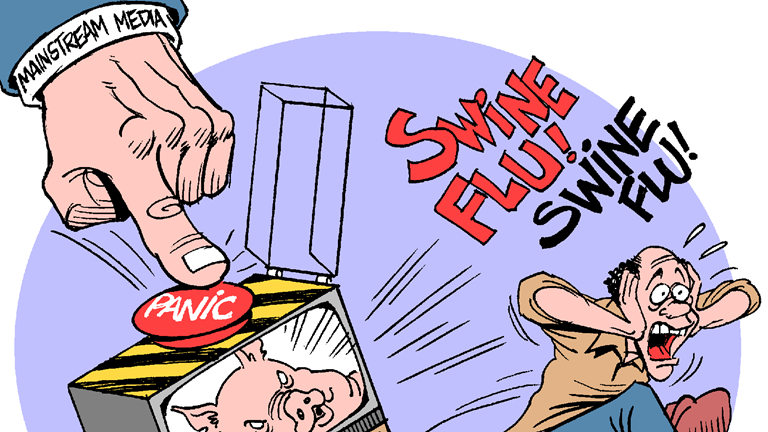
Lesson Drawing Political Cartoons
In this 9-12 lesson, students will analyze cartoon drawings to create an original political cartoon based on current events. Students will apply both factual knowledge and interpretive skills to determine the values, conflicts, and important issues reflected in political cartoons.
- English & Literature
- Grades 9-12
- Comics & Animation
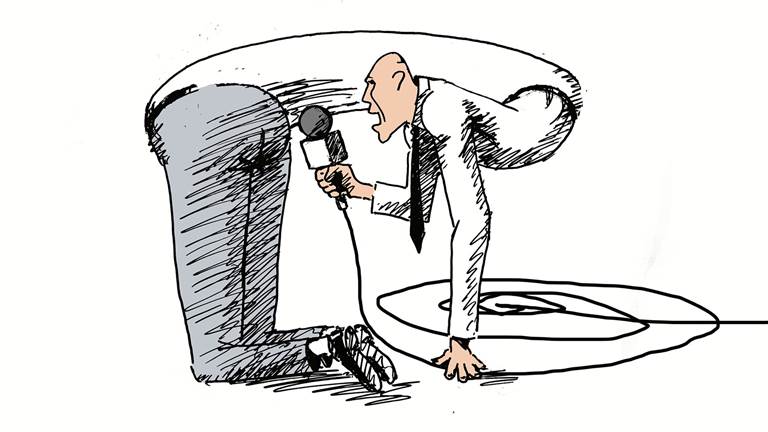
Lesson Media Awareness I: The Basics of Advertising
In this 6-8 lesson, students will examine the influence of advertising from past and present-day products. Students apply design principles to illustrate a product with background and foreground. This is the first lesson designed to accompany the media awareness unit.
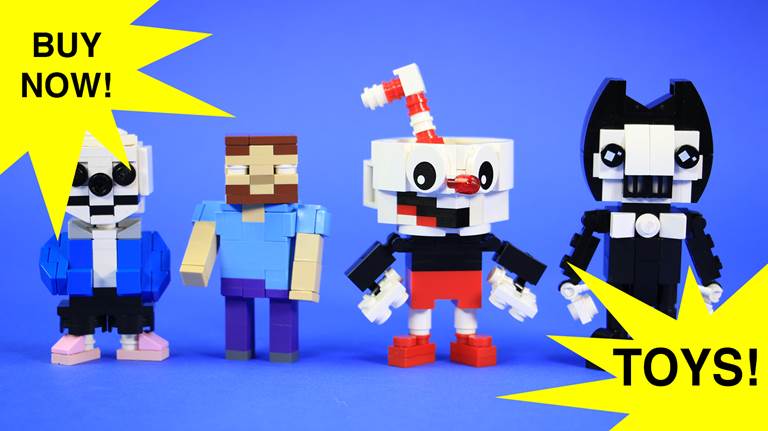
Article Developing an Artistic Eye for the Math Classroom
Middle school math teachers will unlock students’ “artistic mathematical eye” with arts objectives, lesson openings, essential questions, and student choice.
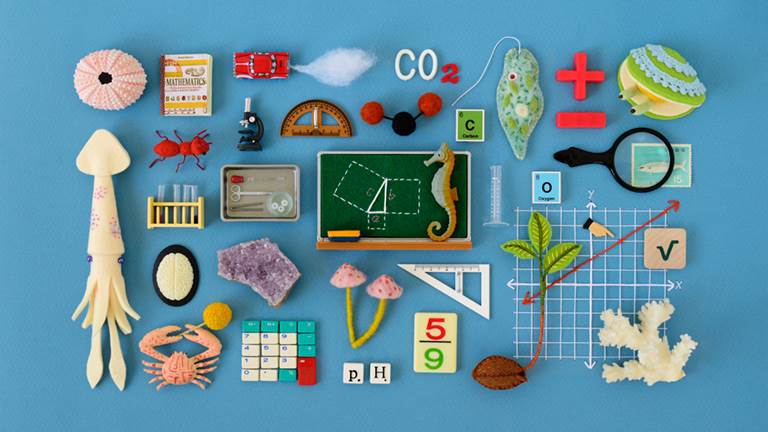
Lesson Composing and Clapping Rhythms
In this 3-5 lesson, students will clap rhythm sequences and compose an eight-measure composition. Students will explore rhythm concepts, including the names and symbols associated with music notation. They will also compare rhythmic sequences to math concepts.

Lesson Counting Crows: Puppet Problem Solving
In this 3-5 lesson, students will infer the moral of a story and compare two mediums of Aesop’s fable, “The Crow and the Pitcher.” Each student will design their own puppet to act out the fable using pebbles and water in containers. Students will make predictions about Crow’s strategy then make comparisons with their findings.
- Myths, Legends, & Folktales
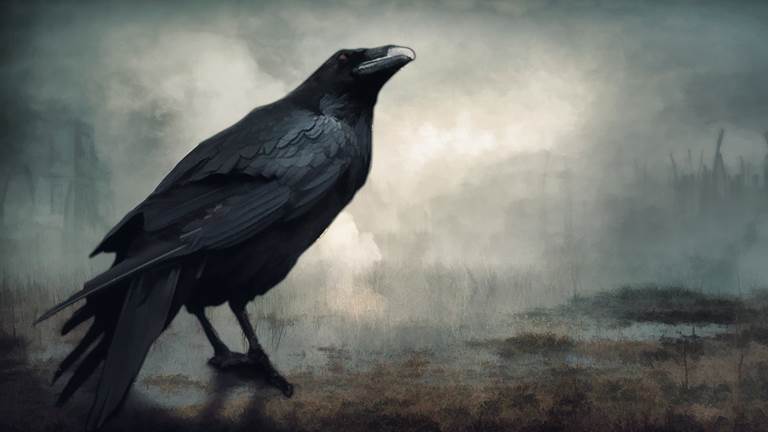
Lesson Creating AB Patterns
In this K-2 lesson, students will construct patterns using visual arts designs and math manipulatives. They will identify patterns existing in the natural and man-made world, art, math, and science.
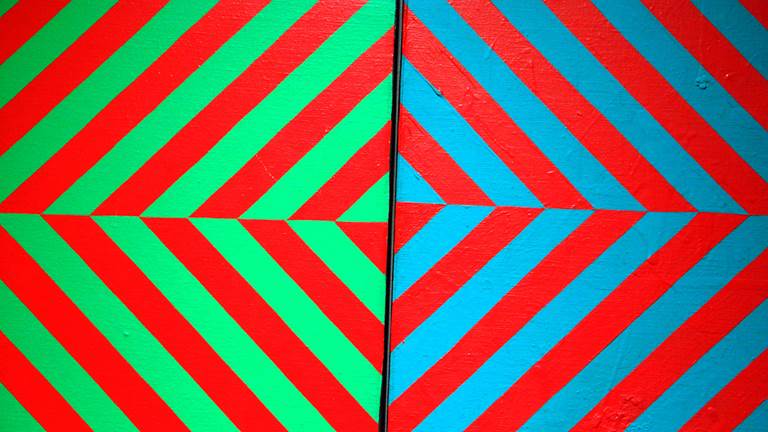
Kennedy Center Education Digital Learning
Eric Friedman Director, Digital Learning
Kenny Neal Manager, Digital Education Resources
Tiffany A. Bryant Manager, Operations and Audience Engagement
Joanna McKee Program Coordinator, Digital Learning
JoDee Scissors Content Specialist, Digital Learning
Connect with us!
Generous support for educational programs at the Kennedy Center is provided by the U.S. Department of Education. The content of these programs may have been developed under a grant from the U.S. Department of Education but does not necessarily represent the policy of the U.S. Department of Education. You should not assume endorsement by the federal government.
Gifts and grants to educational programs at the Kennedy Center are provided by A. James & Alice B. Clark Foundation; Annenberg Foundation; the Andrew W. Mellon Foundation; Bank of America; Bender Foundation, Inc.; Carter and Melissa Cafritz Trust; Carnegie Corporation of New York; DC Commission on the Arts and Humanities; Estée Lauder; Exelon; Flocabulary; Harman Family Foundation; The Hearst Foundations; the Herb Alpert Foundation; the Howard and Geraldine Polinger Family Foundation; William R. Kenan, Jr. Charitable Trust; the Kimsey Endowment; The King-White Family Foundation and Dr. J. Douglas White; Laird Norton Family Foundation; Little Kids Rock; Lois and Richard England Family Foundation; Dr. Gary Mather and Ms. Christina Co Mather; Dr. Gerald and Paula McNichols Foundation; The Morningstar Foundation;
The Morris and Gwendolyn Cafritz Foundation; Music Theatre International; Myra and Leura Younker Endowment Fund; the National Endowment for the Arts; Newman’s Own Foundation; Nordstrom; Park Foundation, Inc.; Paul M. Angell Family Foundation; The Irene Pollin Audience Development and Community Engagement Initiatives; Prince Charitable Trusts; Soundtrap; The Harold and Mimi Steinberg Charitable Trust; Rosemary Kennedy Education Fund; The Embassy of the United Arab Emirates; UnitedHealth Group; The Victory Foundation; The Volgenau Foundation; Volkswagen Group of America; Dennis & Phyllis Washington; and Wells Fargo. Additional support is provided by the National Committee for the Performing Arts.
Social perspectives and language used to describe diverse cultures, identities, experiences, and historical context or significance may have changed since this resource was produced. Kennedy Center Education is committed to reviewing and updating our content to address these changes. If you have specific feedback, recommendations, or concerns, please contact us at [email protected] .
By using this site, you agree to our Privacy Policy and Terms & Conditions which describe our use of cookies.
Reserve Tickets
Review cart.
You have 0 items in your cart.
Your cart is empty.
Keep Exploring Proceed to Cart & Checkout
Donate Today
Support the performing arts with your donation.
To join or renew as a Member, please visit our Membership page .
To make a donation in memory of someone, please visit our Memorial Donation page .
- Custom Other


Odyssey Comic Strip Creative Assignment
The Odyssey by Homer comic strip assignment.
Save more than 20% when you purchase this as a BUNDLE:
The Odyssey Activity Bundle
This is one of my favorite projects for Homer’s “The Odyssey.” Students use 11×17 in. legal paper to create a comic strip that retells the story of Odysseus and his encounter with the Cyclops.
This assignment is aligned with the common core curriculum, and requires students to cite dialogue in MLA format as well as include original narration.
Students will analyze and discover the basis of the conflict of the poem with this assignment.
Other Resources for The Odyssey That Might Interest You:
The Odyssey Board Game Project
The Odyssey Group Research Project
The Odyssey Character Analysis Essay
The Odyssey Differentiated Writing Responses
The Odyssey Vocabulary Packet
The Odyssey Character Analysis Graphic Organizers

SUBSCRIBE NOW
Reading & Making a Comic Strip: Language Arts Activities for Inclusive Classrooms
- Tricia Wegman
- Categories : Inclusion strategies for mainstreamed classrooms
- Tags : Special ed information for teachers & parents
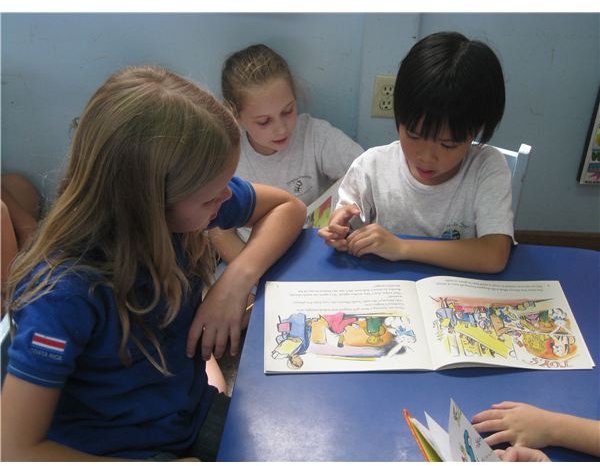
Inclusive classrooms have become more of a norm than an exception in today’s schools. Creating lesson plans for inclusion can mean a little extra work, but planning out differentiated instruction will enrich your classroom environment. This plan is an example of how to split a language arts plan into levels to meet the needs of all learners in the classroom.
Group 1: General Education students
Group 2: Students with access needs (i.e. students who receive the same curricular content, but receive accommodations in how information is presented or skills are evaluated due to a learning difficulty.)
Group 3: Students with curricular content adjustments.
Lesson 1 Objectives:
- Students will show reading proficiency according to their reading level.
- Students will demonstrate understanding by correctly portraying the story plot line.
- Popsicle sticks
- Leveled reading books
- White paper for students to create comic strips
- Typed up plot points for group 2
- Pictures of plot points for group 3
- Assessments
Lesson Procedure:
1. Group listening activity. Read a story to the class and tell them to listen for a particular word. Give each student a Popsicle stick to raise up whenever they hear the particular word read in the book. This activity is great for students with more challenges since they will be able to imitate the rest of the class and participate without needing teacher intervention.
2. Differentiated instruction
Group 1: This group will read their leveled book in small groups or with partners. Once finished, students will work individually on a comic strip. Have them choose 4-5 main points in the story plot and put them in the correct sequence. For each plot point, have them draw a picture and write a sentence in the caption.
Group 2: This group will read their leveled book in a small group with a teacher. Teacher will guide the students as they read. Once finished, students will receive paper strips of plot points that were previous typed up. Have students choose the most important 4-5 plot points and glue them onto another piece of paper in sequence. Draw a picture for each strip.
Group 3: This group will listen to the teacher read as they follow along. Once finished, students will receive paper strips with pictures from the story. Have the students put the pictures in the correct sequence and paste them onto another piece of paper. Have students dictate as the teacher writes what each picture was about.
Assessment:
- Group 1 Format: Short answer. Ask questions that students can answer with 1-2 sentence responses.
- Group 2 Format: Multiple Choice. As the same questions as the test for group 1, but have multiple choice answers so that students aren’t penalized for any writing difficulties.
- Group 3 Format: Use the same pictures from the activity and have students put the plot pictures in the correct order from memory.
This plan can be accommodated according to each child’s needs. Knowing your students skills and abilities, as well as understanding their 504 plan or IEP will help you as a teacher know how to plan for your class successfully!
This post is part of the series: Differentiated Instruction for an Inclusive Classroom
Many teachers now experience classrooms with students of all abilities. This series includes activities for language arts, social studies, science and math.
- Differentiated Instruction for an Inclusive Classroom: Language Arts
- Working with Fractions in a Centers-Based Environment
- Differentiated Instruction for an Inclusive Classroom: Social Studies
- Tracking the Growth of a Plant: Science Activity for Inclusive Classrooms

10 Most Wholesome Calvin And Hobbes Comic Strips
Calvin and Hobbes is known for ridiculous scenarios, monstrous snowmen, and a stuffed tiger who loves tuna fish sandwiches. Calvin is a rambunctious little boy who loves teasing his classmates and tormenting his parents. His various chaotic dynamics create a ridiculously fun environment.
As wild as Calvin is, though, there are some touching moments in the strip. Some strips revolve around Calvin roaming around and having fun, some involve him bonding with his family, and some feature typical childhood antics that are downright heartwarming. Those strips happen to be the most wholesome in Calvin and Hobbes .
Calvin and Hobbes Play Football
Published october 25, 1992.
When they play games, Calvin and Hobbes typically play Calvinball. The game involves endless exploration and ever-changing rules. While that often involves some level of violence, the October 25, 1992 strip features a wholesome version of the two friends instead playing football.
Because Calvin and Hobbes takes place in a rural area, the characters can race through the forest and hide in sandpits. It's heartwarming to see them just playing their equivalent of tag. It's also hilarious to think of Calvin dragging his stuffed friend through endless environments and trying to squeeze himself into a mailbox. It's as charming as it is wholesome fun.
Calvin Cures Hiccups
Published april 20, 1989, why are they named calvin and hobbes.
Anyone can relate to the struggle of having hiccups. It can feel impossible to get rid of them, and most six-year-old kids will try anything to ease the burden. They chug water, hold their breath, and might even stand on their heads. However, the funniest part of this strip is Calvin trying to do what he loves anyway.
The idea of a young boy scooping sugar into his mouth to ease hiccups is funny because it is disconnected from the actual reason for his hiccups. Unlike Calvin's typical antics , eating sugar is a wholesome way of curing his problems. His smile at the end shows just how pleased he is with himself, and it's adorable.
Hobbes Goes For a Swim
Published june 28, 1988.
Most of Calvin's shenanigans involve him doing something that he already knows is wrong. He brings bugs to show-and-tell , creates evil snowmen, and even bites people. The June 28, 1988 strip is relatively unique because Calvin actually does listen to his mom. When she tells him that Hobbes cannot swim, he dedicates himself to helping his friend.
Instead of ignoring his mother and putting Hobbes at risk, Calvin gets swimming gear to put on Hobbes. His jubilant smile when asking his mom about Hobbes shows his love for his stuffed tiger and his usually shrouded respect for his mom. It's a wholesome example of a misunderstanding that a six-year-old can have.
Calvin's Dad Reads To Him
Published april 4, 1991.
Because Calvin is such an adventurous child, he usually fights his parents when they send him to bed. One part that he seems to enjoy, however, is listening to his dad read stories to him. Calvin and his dad spend time together and bond over whichever story Calvin wants to hear that day.
Even for a Calvin and Hobbes punchline , the April 4, 1991 strip ends with a mild snark rather than a typical Calvin insult. Even the idea of Calvin needing to write a paper on the book still implies that he wants to listen to his dad read to him rather than read by himself. He may still be dodging his assignment, but it's a wholesome moment when he implies his love for reading time with his dad.
Susie Tricks Calvin
Published january 13, 1986.
Despite being one of the best Calvin and Hobbes characters , Susie is often the butt of every joke. As a typical little girl, she wants to enjoy tea parties and playing house. Calvin, who is far more interested in causing chaos, often torments her. He typically ruins her games, cheats on her homework assignments, and throws snowballs at her.
The January 13, 1986 strip is surprisingly wholesome because it flips their dynamic. Instead of Calvin tormenting Susie, she uses her brains to get the edge over him for once. Even then, she doesn't do much more than call him a " stinkhead ." It's adorable and makes their dynamic feel a little more even.
Calvin and Hobbes Hug for Christmas
Published december 25, 1990, calvins best show-and-tell items in calvin and hobbes.
Christmas is always a fun time for Calvin and Hobbes, especially since Calvin loves waking his parents early to open up his gifts. Yet, while he could have prepared a tuna fish sandwich for Hobbes, he forgot about his best friend in the December 25, 1990 strip.
However, the wholesome element of this strip is that Calvin embraces Hobbes after realizing that he forgot to buy him a gift. It's a rare moment wherein Calvin sets aside his impulsive desires to show his love for his friend . He delays gratification for Hobbes' sake, which is exactly what makes this moment so great.
Calvin and Hobbes Appreciate the Snow
Published december 31, 1995.
The final Calvin and Hobbes strip has no punchline at the end. Instead, Calvin and his friend walk into a forest filled with snow. Together, they put a sled down, get together, and elect to explore it. There is nothing funny about the strip, nothing chaotic, and nothing especially problematic about Calvin's behavior.
It's nothing but a wholesome strip that sees two friends explore a " magical world ." While it's a memorable strip that can break hearts , it is wholesome in that the two friends aren't doing anything wrong. They are just roaming the world and having fun. It's a sharp reminder of childhood snow days and the beauty of an ever-changing world.
Calvin Helps His Sick Mom
Published november 6, 1986.
Calvin is not generally the best child but is sometimes a great son. When Calvin found out that his mom was sick, he offered to read a story to her and then reflected on how difficult it was to be a mom for his mom. Touched, Calvin's mom hugged him and called him " sweetie ."
It's an adorable moment that shows one of the rare rewarding experiences in Calvin's mom's struggle to raise her son . Because he is such a difficult child, seeing him genuinely care for her shows she is doing a good job as a parent. Even if Calvin is upset at the hug, his display of empathy is truly wholesome.
Calvin's Mom Saves Hobbes From the Rain
Published october 3, 1993, ending calvin and hobbes is exactly what saved it.
Because Calvin spends so much time at the bus stop with Hobbes, it can be easy to forget that Hobbes is a stuffed animal who will not be able to get home by himself. The October 3, 1993 strip revealed that Calvin's mom always brings Hobbes in for him . This detail was never revealed before, and it was a sign of her devotion to keeping her son's creativity alive. It's another sign of just how much this family loves each other.
Unfortunately, it may be a sad strip for Calvin. He has to spend time in school without Hobbes, but there are even more wholesome elements. His goodbye to Hobbes is touching, as is Hobbes' desperate desire to see his friend again. They may be far away, but their love for each other is a truly resounding and palpable connection.
Calvin's Dad Goes To Play in the Snow
Published january 14, 1990.
Because Calvin's dad is always devoted to working , he is rarely a fun dad. At best, he tends to tease his son with fake stories about obscure topics. He rarely goes out and plays with him, though. The January 14, 1990 strip lets Calvin spend some time in the snow with his dad, and there's nothing better than that.
It's wholesome to see Calvin desperately want to play with his dad , and it's even more touching to see Calvin's dad put away his work to bond with his son. The final strip of Calvin kissing his forehead as he returns to work shows how much love exists within that family.
Calvin and Hobbes
From 1985 to 1995, Calvin & Hobbes had a legendary run in newspaper comics. Almost 30 years later, Bill Watterson's strip about an imaginative, chaotic child and his stuffed tiger is still one of America's most popular comic strips. Known for its versatile art style, sense of whimsy and imagination, and realistic characters, Calvin & Hobbes is easily one of the funniest and smartest 20th Century comics.
Writer Bill Watterson
Publisher Andrews McMeel Publishing
Artist Bill Watterson

How a Century-Old Comic Strip Led to the Creation of Star Wars
The origins and inspiration for George Lucas' space opera, Star Wars, had surprisingly early roots.
- The Buck Rogers comic strip set the stage for Star Wars , inspiring George Lucas to create his own galactic saga.
- Lucas honed his filmmaking skills with American Graffiti before pursuing his dream of making big-budget sci-fi.
- Collaboration with colleagues and advice from industry veterans shaped Star Wars into the iconic franchise we know today.
"The more things change, the more they stay the same," French writer Jean-Baptiste Alphonse Karr wrote in 1849. During the following century, a real-life epoch that proved the quote true was set in motion when writer Philip Francis Nowlan created a character known as Anthony Rogers for his 1928 novella Armageddon 2419 AD . The following year, the character would be reconstituted for the Buck Rogers comic strip , moving from literary side note to a hugely successful comic with a nearly 4-decade run that inspired countless radio and television serials. The comic would heavily influence a generation of sci-fi filmmakers, none more so than George Lucas with Star Wars . With Buck Rogers , the concept of the 'space opera' was born , inspiring a slew of copycat strips like Flash Gordon .
As a child, Lucas took a serious interest in these characters, both in their comic form (illuminated by the likes of illustrator Frank Frazetta) and the early serial films that laid the groundwork for everything after. Lucas used the serial format and the design elements of artists like Frazetta to build his own galaxy.
George Lucas' Pursuit of Science Fiction First Required a Hit Film
After a stint at the University of Southern California, Lucas moved home to San Francisco in 1967, co-founding American Zoetrope with filmmaker Francis Ford Coppola. Lucas had already made sci-fi his forte while in film school, and he extrapolated one of his student films into his first feature for Coppola's American Zoetrope production house in 1971 — a film called THX 1138 .
Despite positive reviews from critics, THX 1138 was a box office bomb. Undeterred, Lucas decided to make a more audience-friendly film two years later, still under Coppola's banner, with his coming-of-age comedy, American Graffiti . The film became a smash hit, eventually generating a $140-million box-office gross (nearly a billion dollars, adjusted for inflation). The film's success would allow Lucas the leverage to pivot to the pursuit of his favored genre — science fiction.
Why Star Wars Fans Are Upset With George Lucas Again
While his second feature catered to Lucas' own early-'60s childhood, he yearned to adapt his comic book inspirations for film, to make something like THX , but with an adequate budget, that mimicked the scale of Stanley Kubrick's miniatures for 2001: A Space Odyssey — even outdid them. While American Graffiti may have been a lifetime achievement for most directors, Lucas had bigger plans. Of note, then, was a bit part in Graffiti from an actor that would later figure largely in Lucas' life: Harrison Ford.
The Journey from Buck Rogers to Star Wars: A New Hope
Determined not to repeat the mistakes he made with THX , Lucas pursued a film concept that focused less on artistic merit and more on audience entertainment — targeting young teens. Accordingly, he attempted to acquire the film rights for two of his favorite serials, Buck Rogers and Flash Gordon .
With the Buck Rogers character already being developed by NBC for a television series, Lucas instead focused on developing a Flash Gordon feature film, enlisting the aid of producer Gary Kurtz, who had helped make American Graffiti a phenomenon after returning from a tour in Vietnam. Born a Quaker, Kurtz had enlisted as a 'conscientious objector' and didn't carry a sidearm during the Vietnam War, but his peaceful nature belied a childhood love for the same action serials that had inspired Lucas. Unfortunately, like Buck Rogers , Flash Gordon was caught up in licensing issues, forcing Lucas and Kurtz to start from scratch in order to make their serial space opera. That proved to be a blessing in disguise when the script for Star Wars: Episode IV - A New Hope began to take shape.
The Key Players in Star Wars Take Shape
While Buck Rogers ' DNA remained firmly entrenched in Lucas' concept for Star Wars , by the script's second draft, Lucas clearly needed to move away from his source material. Lucas' partner at American Zoetrope, Francis Ford Coppola, had cast doubt over Lucas' ability to write dialogue, and Gary Kurtz had later expressed that Lucas' Star Wars script was still "gobbledygook."
Lucas hired a few film school compatriots, Willard Huyck and Gloria Katz, to punch up his script. Allowing input from his colleagues helped Lucas commit to crucial decisions (like making Han Solo a human instead of the original "frog-like alien" and Luke Skywalker a young man instead of a grizzled character more like Buck Rogers). Steven Spielberg, Coppola, Brian De Palma, and Martin Scorsese all offered opinions after Lucas screened an unfinished version of the film.
One key decision was contributed by Lucas' old friend, director Brian De Palma, who suggested that the famous text crawl in the film's intro (a nod to the Buck Rogers serials) would help encapsulate the "galaxy far, far away" for the audience. Star Wars had already made a quantum leap from mid-century sci-fi, but this nostalgic touch tapped the audience's suspension of disbelief.
Every Brian De Palma Film of the 1980s, Ranked
After a tense production, star wars: a new hope comes to fruition.
With the advice of his crew of the "Movie Brats" (to quote a term from film critic Pauline Kael), Lucas was encouraged to maintain the tone of their favorite childhood serials, even using the artwork of Frank Frazetta as the basis of his team's spaceship and costume designs. The Disney+ documentary Light & Magic provided the deepest dive into the fragile dynamic of Lucas' ragtag crew of creatives tasked with making A New Hope a reality. Lucas had begun forming his Visual Effects company, later to become Industrial Light & Magic, in Van Nuys, California, with the help of John Dykstra — an effects MacGyver who could help Lucas' grandiose ideas come to life. Lucas and Dykstra had complementary skills, but personalities that clashed — leading to Dykstra's exclusion when Lucas eventually moved the company North to San Rafael, California.
Despite a tense production that ran over budget and far beyond the original shooting schedule, the design team that became ILM made groundbreaking designs like the Millenium Falcon, and camera innovator Richard Edlund used new motion control techniques to help Lucas' vision for high-speed dogfights in space. These were the elements that brought Star Wars light years ahead of Buck Rogers and Flash Gordon , which nonetheless remained a huge influence on the look of the films — as well as drawing a blueprint for the serial format that has made Star Wars so immensely lucrative. The Star Wars franchise is streaming now on Disney+.
Buni by Ryan Pagelow for April 10, 2024
April 08, 2024.
All caught up!
More from buni.

Explore Buni
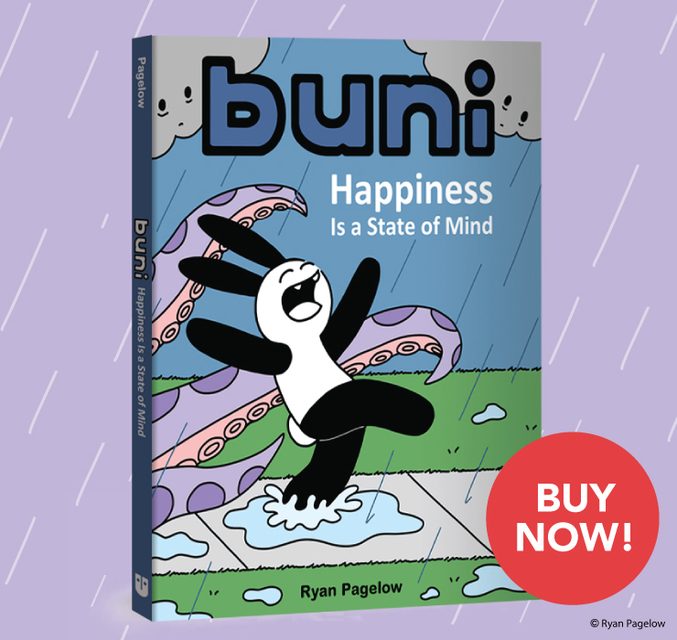
Latest Tweet
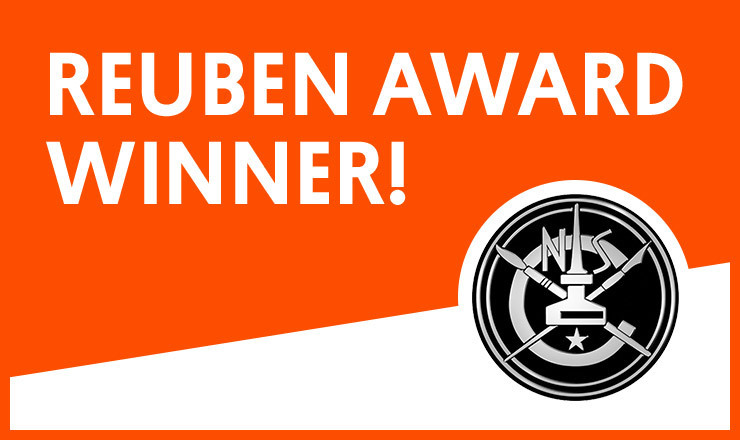
2013 Reuben Award Winner

Ryan Pagelow (Buni)
September 04, 2013
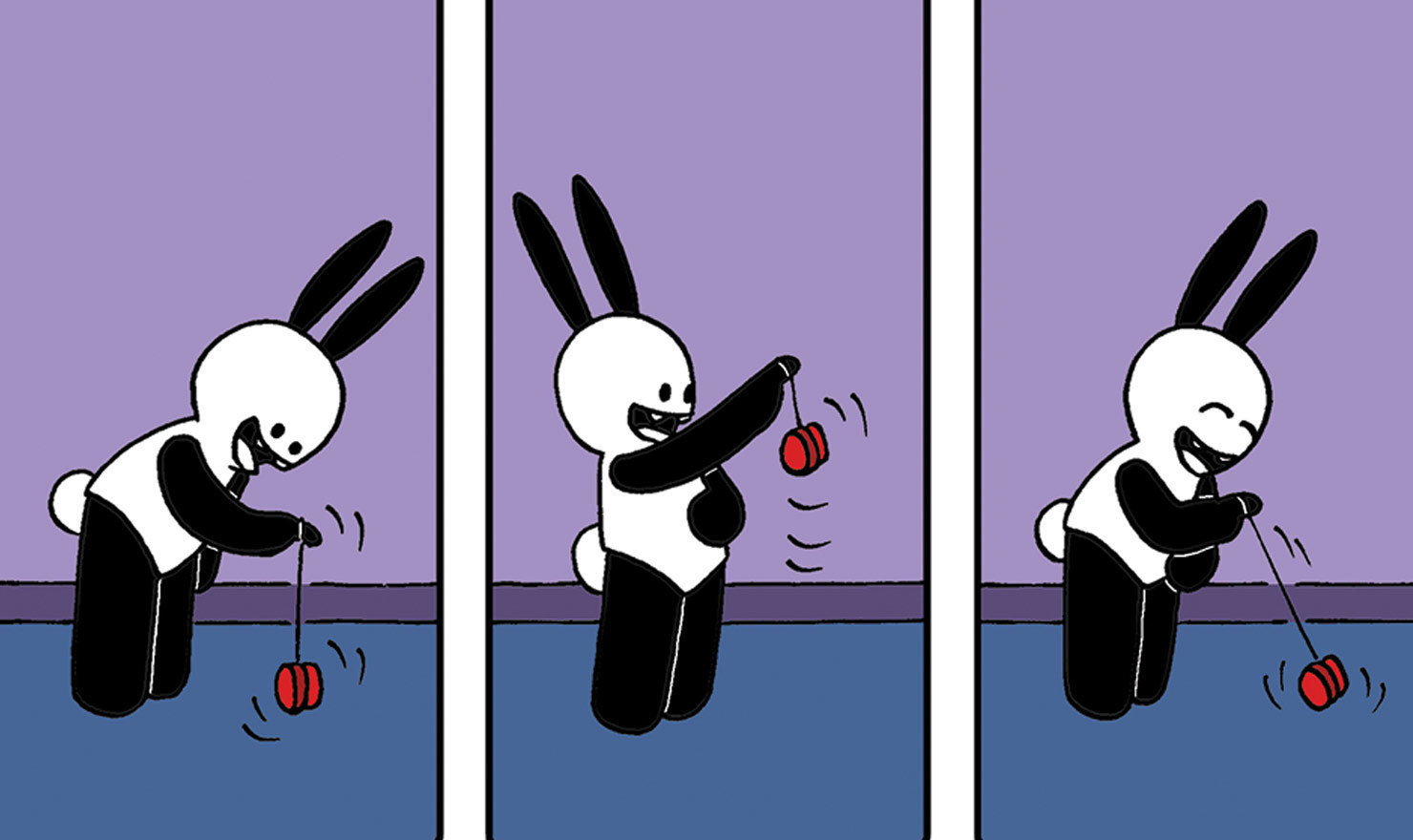
National Yo-Yo Day Has Come Back Up Again In These Comics
The gocomics team.
June 06, 2017
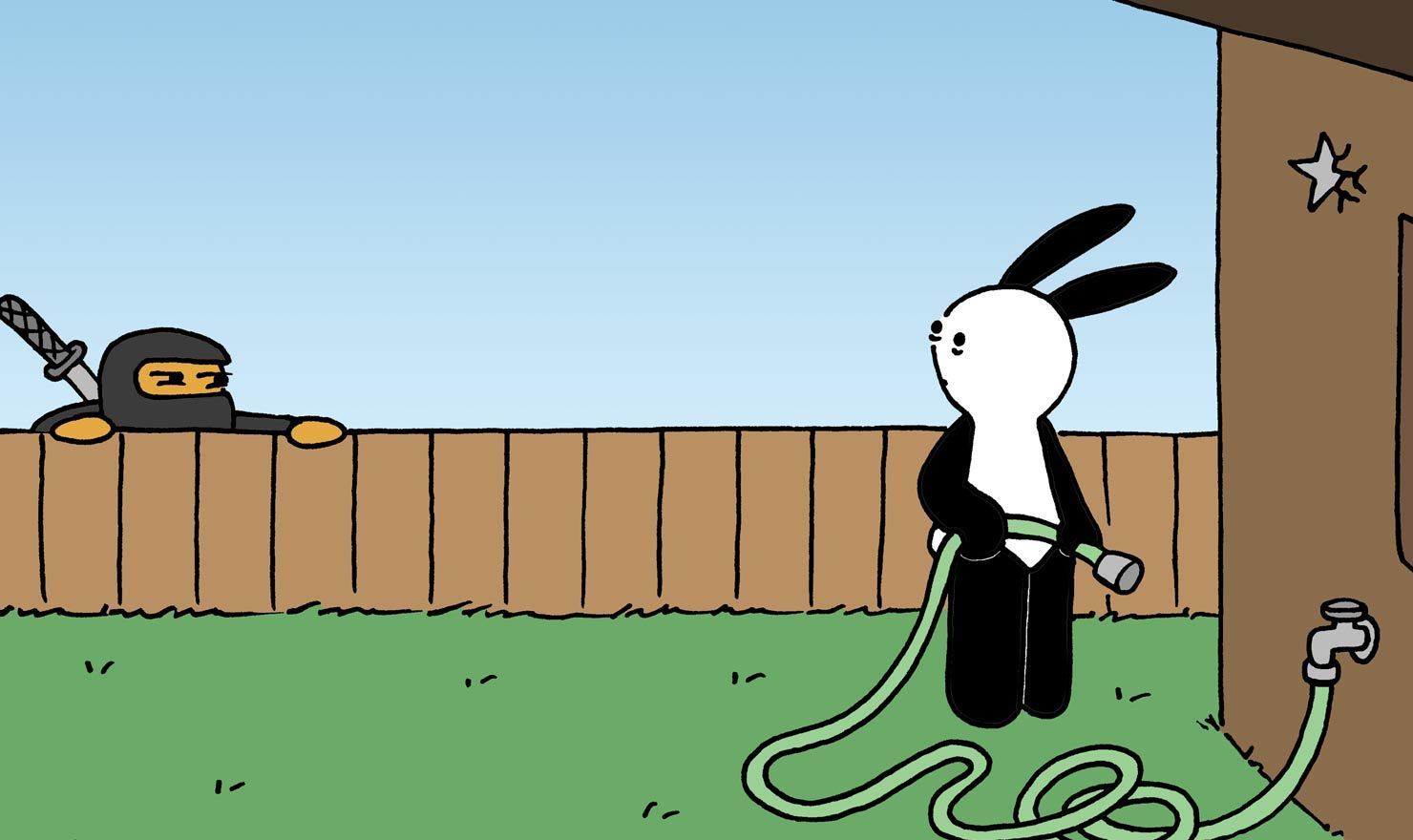
10 Ninja Day Comics That Strike Hard And Fade Into The Night
December 05, 2017

Wed, April 10, 2024

Tue, April 9, 2024

Mon, April 8, 2024

Sun, April 7, 2024

Sat, April 6, 2024

Fri, April 5, 2024

Thu, April 4, 2024

Wed, April 3, 2024

Tue, April 2, 2024

Mon, April 1, 2024

Want more Dustin?
Upgrade to get premium access. Unlock 250,000+ comics, and join in the fun.
Shop Dustin prints, shirts, and more

IMAGES
VIDEO
COMMENTS
Templates for Comic Strips 1. This panel template contains 6 boxes with alternating size in each row. In general, the layout goes in two columns and three rows. The column width in each row is at alternating size. For example, in the first row, it begins with a column of about 40% width, and the right column that is the second column is at ...
Today, I have 15 ready-to-use comic strip templates for your next lesson. These are super simple and ready for you to use "as is" or customize for your students. I've also included tips for creating your own comic strips using templates you can find in three popular tools. And if you're new to using comics and not sure if it's for you ...
Comic Strip LESSON PLAN. THREE: Using one of the comic strip templates provided, elicit ideas for a story and put the results on the board. Use fewer words than in the sample board plan below - keep to the main points and use verbal communication as much as possible. Board Plan.
Create a Comic Strip. When you think of writing skills, you probably remember long essays, research reports, tests, or other stressful school assignments. But communicating using the written word doesn't have to be tough! It can be as simple as telling a story, as rudimentary as writing a wish list, or as fun as composing a comic strip.
A 32-page comic on how our government works. Using the power of comics to teach teens about the way our government works This Is What Democracy Looks Like, A Graphic Guide To Governance is a 32-page comic book created by The Center for Cartoon Studies (CCS). This short comic guide helps to bring democracy back to the hands of the people by explaining what democracy actually means and how the ...
Thanks for visiting! Comic strips are awesome ways to enjoy creative writing fun with kids. Pairing drawing with writing, this activity provides kids with opportunities to tap their imagination and practice sequencing and more. Find out how my boys use these printable comic strip resources and get your free pack today! Table of Contents.
Use these comic strip page templates for creative assignments for your students. They can be used to assign comic/cartoon strips about the unit you are studying, a biography of an author or historical figure, or a creative book report. This download includes 30 total templates. Can be used with interactive notebooks, as well!
Once you're satisfied that students understand the assignment, demonstrate the Comic Creator student interactive and discuss its relationship to the Comic Strip Planning Sheet. Be sure to cycle through the options for characters and dialogue bubbles to show students the range of options available. ... To make comic strips, have your students ...
A comic strip tells a story from beginning to end. It is a fantastic option for any activity where you want students to practice sequencing skills. Students can retell the events leading up to a critical historical moment or retell what happened in a story they read. You might provide a list of temporal words for students to use, like: First ...
Blank comic strip template activity idea #1. You can use blank comic strip templates to get students to recount events or summarize. information. For example, in ELA you can get students to review chapters of a novel or short stories. Or, they can show character information. You can also get students to transform a text.
In this assignment, students will: Create a Canva account if required. Choose a comic strip template. Customize the template with their own images, characters, and text. Add dialogue to bring their story to life. Rearrange panels to create the desired layout. Proofread their comic strip to ensure accuracy and clarity.
Launch the tool! The Comic Creator invites students to compose their own comic strips for a variety of contexts (prewriting, pre- and postreading activities, response to literature, and so on). The organizers focus on the key elements of comic strips by allowing students to choose backgrounds, characters, and props, as well as to compose ...
Ages. 7-13. If your child adores comics and graphic novels, encourage him to create his own comic strip using this template. You can brainstorm with him about what to draw — and write — in the comic strip. Or, let your child lead the way, filling in the speech bubbles and drawing in all the boxes. If the story can't fit in just one page's ...
Comic Strip Assignment Rubric Directions: Your comic strip presentation will be graded according to the following rubric. Use the rubric as a guide when creating your comic strip and as a means to self-assess your comic strip before you turn it in. Traits 4 3 2 1 Comic Strip The comic strip demonstrates thorough and evident originality
You can choose which part of the water cycle you want to start with. Click "Start Assignment". Create your narrative in the description boxes. Allow one cell for each step. Create an illustration for each using appropriate scenes, characters, items, etc. Search "face" for different facial expressions. More options.
Alternatively, you could add comic strips as an assignment in between reading and writing a more formal report. That way, students can use their completed comics as guidelines for more formally-written work. Comic strips can be a low-pressure way for students to organize their thoughts. 2. They're so much fun, you don't realize how much you ...
Day Two: The Writing Phase. Once students have made decisions about the elements to include in their comic strips, day two begins the writing phase. Remind students about the structure of plots and how characters work. Consider posting visual reminders around the room so students can reference them as they work.
Students will: Analyze the evolution of comic strips using the familiar Peanuts comic strips and other comic strips. Explore comic strips from the perspective of a story (setting, characters, plot). Evaluate comic strips by looking at words, pictures, and how they work together. Create an original comic strip to convey mathematical information.
Students use 11×17 in. legal paper to create a comic strip that retells the story of Odysseus and his encounter with the Cyclops. This assignment is aligned with the common core curriculum, and requires students to cite dialogue in MLA format as well as include original narration. Students will analyze and discover the basis of the conflict of ...
With a few clicks of the mouse button, you can select from a wide range of hair, skin, eye colors, face and body shapes, and clothing to create a comic version of yourself. The Facebook Bitstrips ...
Lesson 1 Objectives: Students will show reading proficiency according to their reading level. Students will demonstrate understanding by correctly portraying the story plot line. Materials: Book. Popsicle sticks. Leveled reading books. White paper for students to create comic strips. Typed up plot points for group 2.
10 Most Wholesome Calvin And Hobbes Comic Strips. Story by Lukas Shayo. • 12h • 7 min read. Calvin and Hobbes is known for ridiculous scenarios, monstrous snowmen, and a stuffed tiger who ...
View the comic strip for Calvin and Hobbes by cartoonist Bill Watterson created April 06, 2024 available on GoComics.com. April 06, 2024. GoComics.com - Search Form Search. Find Comics. Trending Comics Political Cartoons Web Comics All Categories Popular Comics A-Z Comics by Title. Best Of.
Buy a Print of this Comic. Read the On The Fastrack comic strip from April 10, 2024, and check out other On The Fastrack comics by Bill Holbrook.
Discuss the difference between comic strips and comic books. Comics strips are usually self-contained "gags" or jokes and most-often run in series of three rectangular panels. Comic books run 20 pages or more in length, may be self-contained or part of an ongoing storyline, and vary in their panel layout from page to page based on the action of ...
Buy a Print of this Comic. Load more comics. Read the Suburban Fairy Tales comic strip from April 10, 2024, and check out other Suburban Fairy Tales comics by Francis Bonnet.
Summary. The Buck Rogers comic strip set the stage for Star Wars, inspiring George Lucas to create his own galactic saga. Lucas honed his filmmaking skills with American Graffiti before pursuing ...
View the comic strip for Buni by cartoonist Ryan Pagelow created April 10, 2024 available on GoComics.com. April 10, 2024. GoComics.com - Search Form ... National Yo-Yo Day Has Come Back Up Again In These Comics The GoComics Team. June 06, 2017. Advertisement 10 Ninja Day Comics That Strike Hard And Fade Into The Night The GoComics Team ...
Dustin. Buy a Print of this Comic. Load more comics. Read the Dustin comic strip from April 10, 2024, and check out other Dustin comics by Steve Kelley & Jeff Parker.
Comic Strip Assignment Checklist Assignment Overview: For this assignment, you will be examining the universal theme of betrayal in Roman history. After researching Roman history, you will create a six-panel comic strip depicting a plausible betrayal scene from Roman times. Finally, you